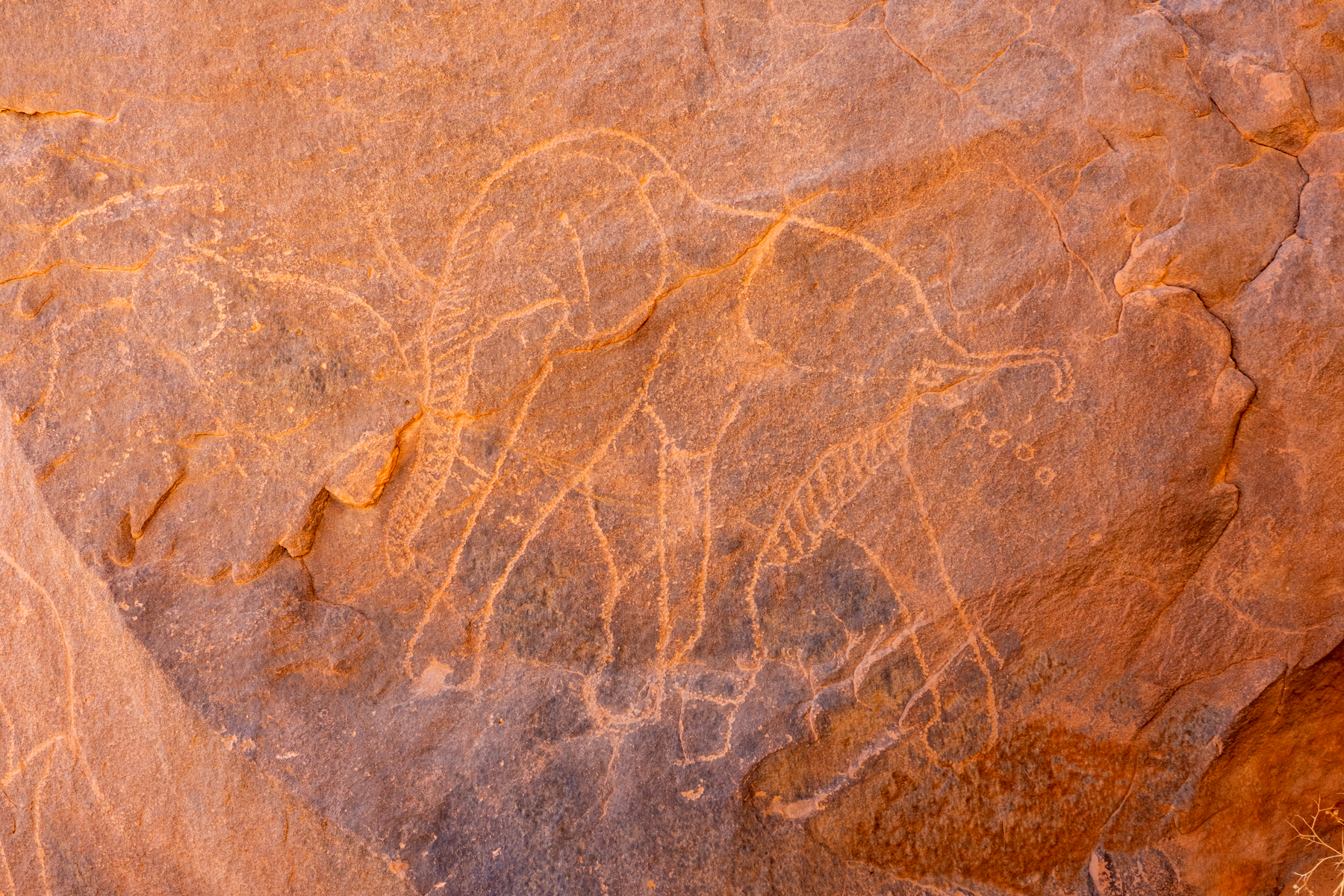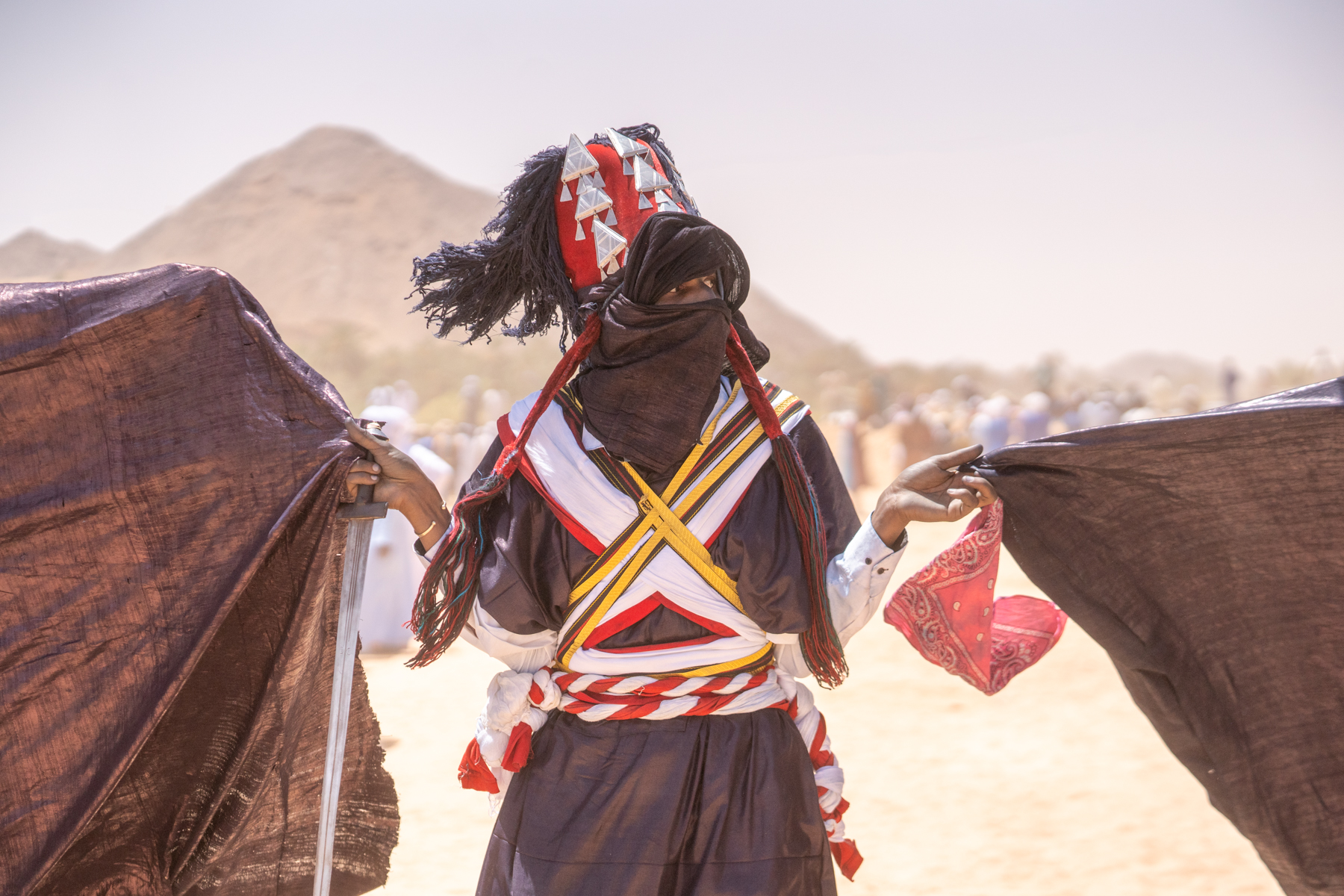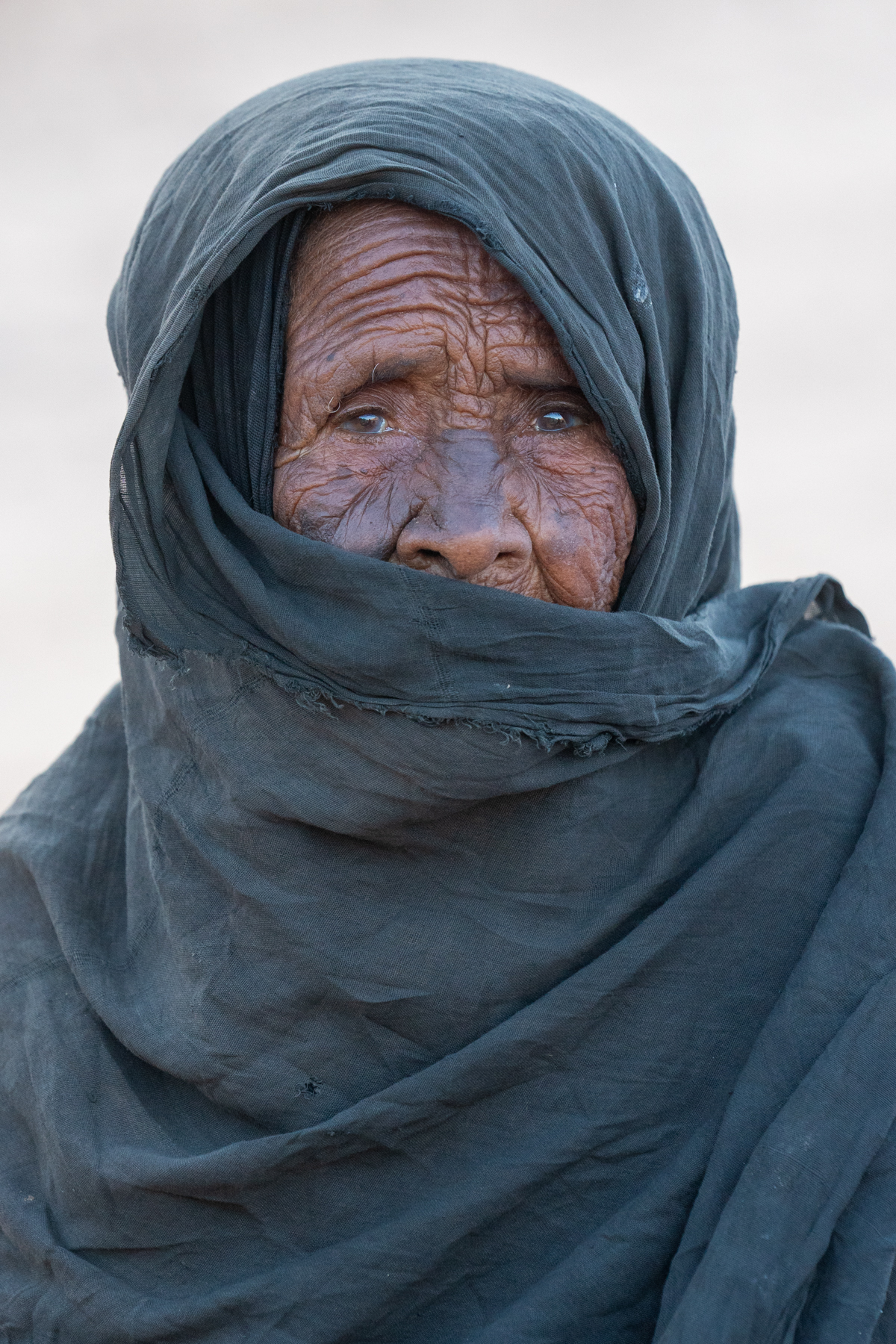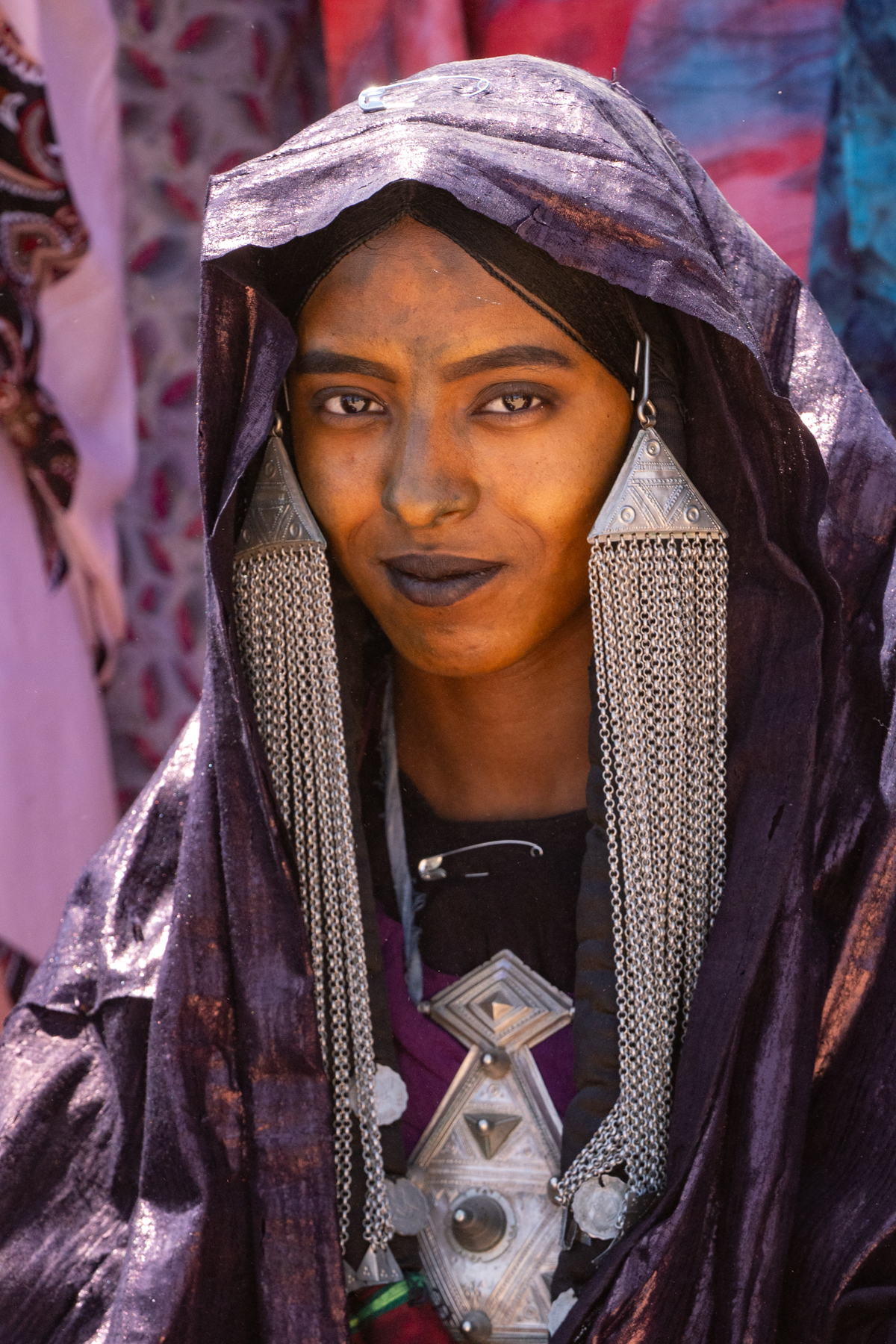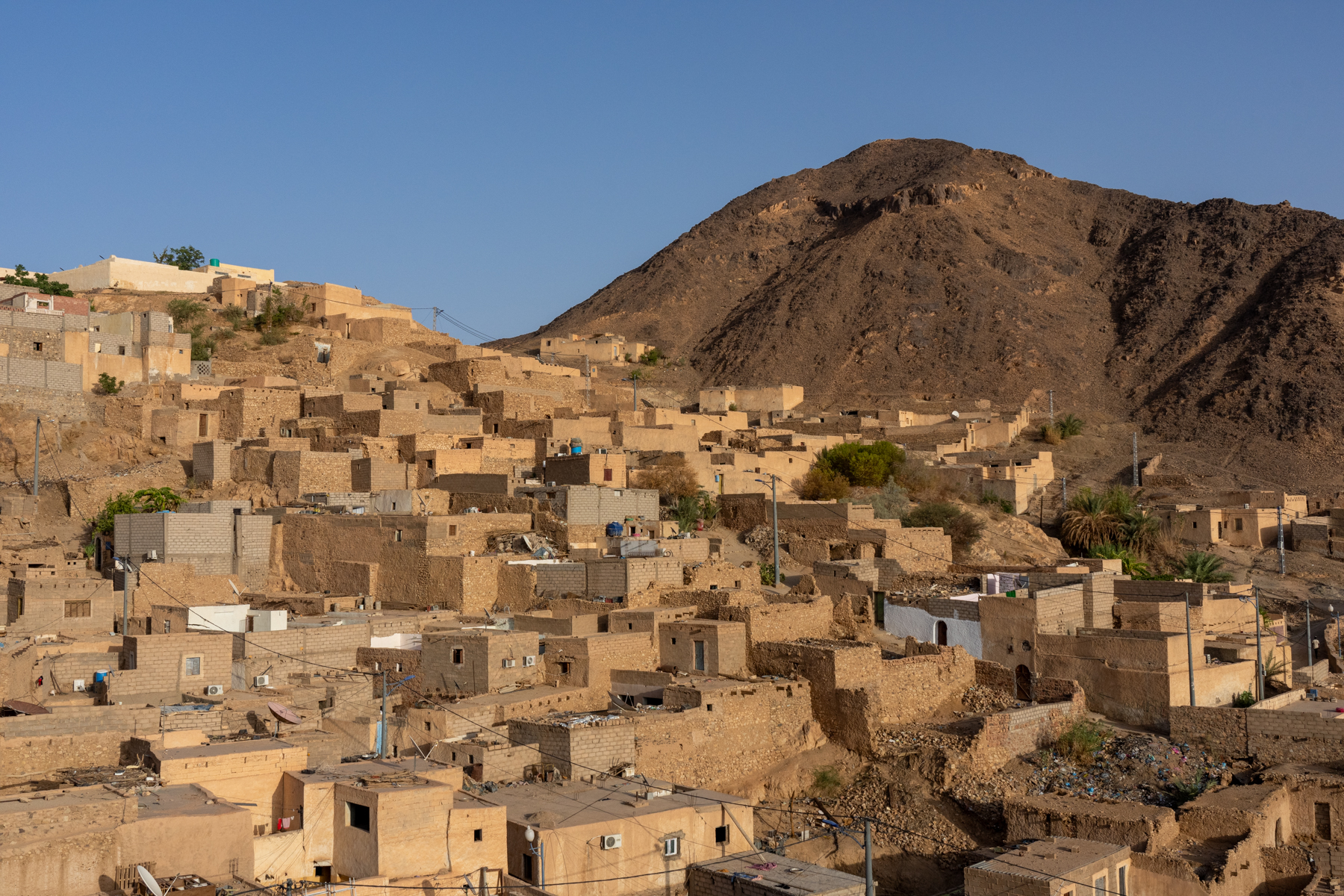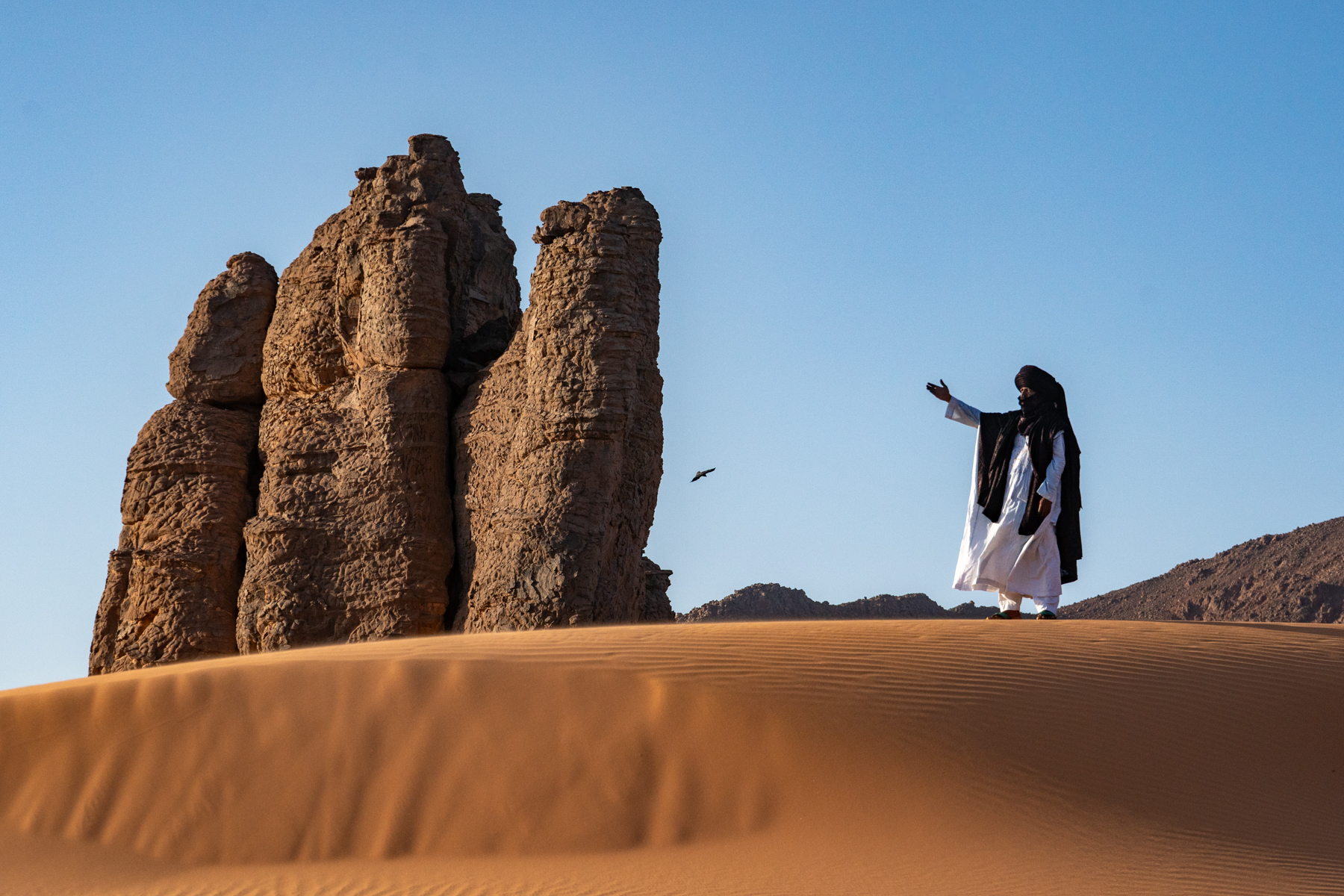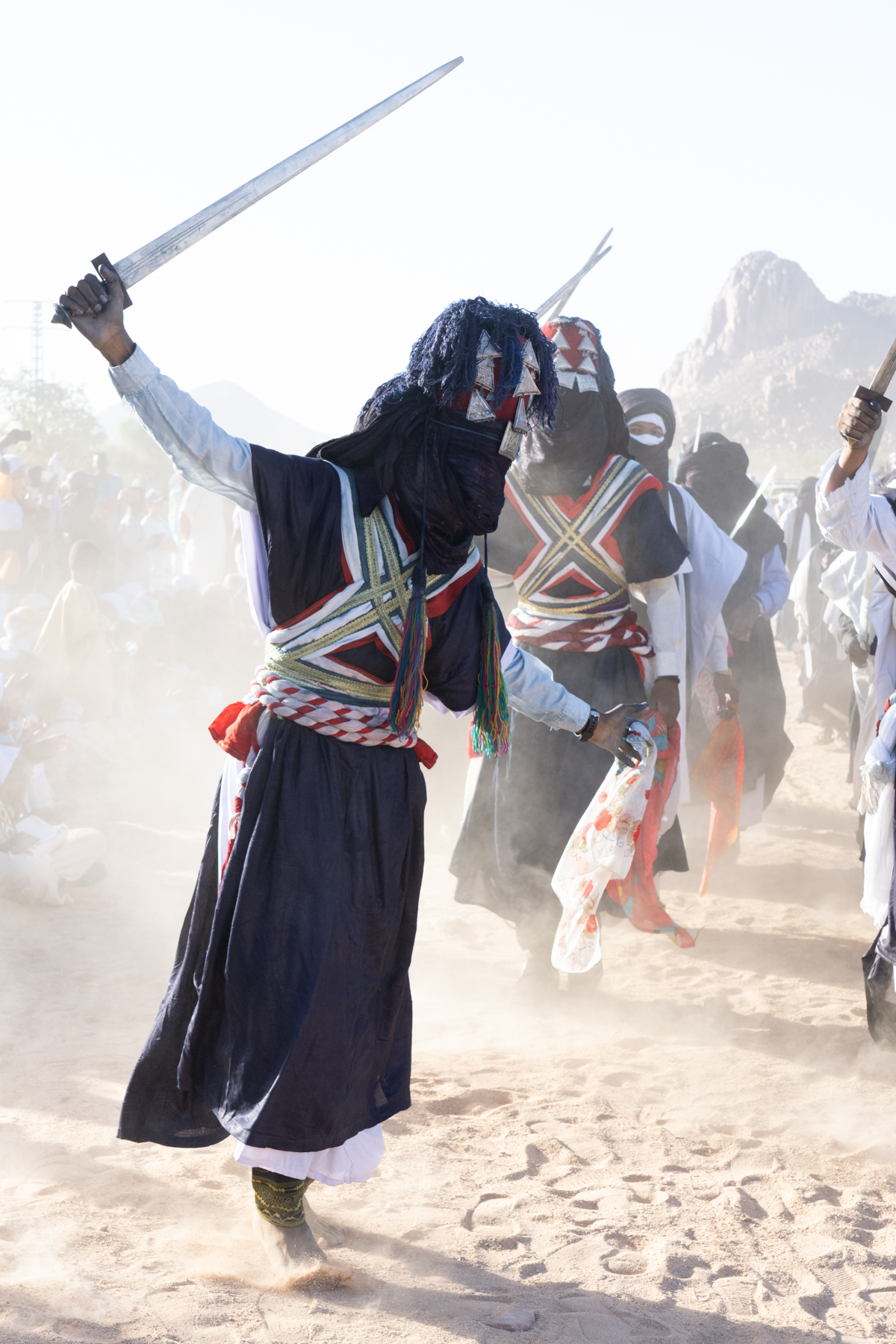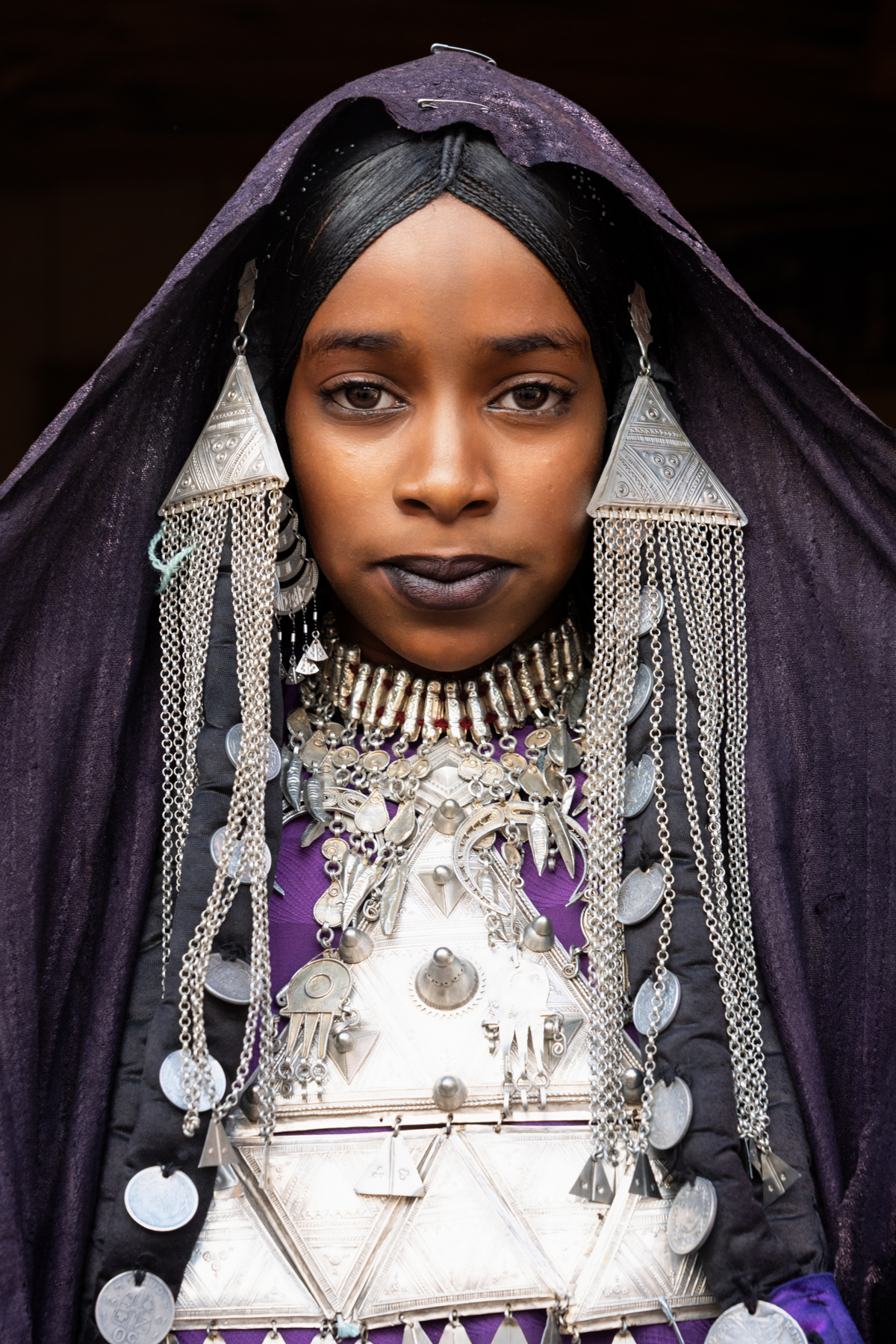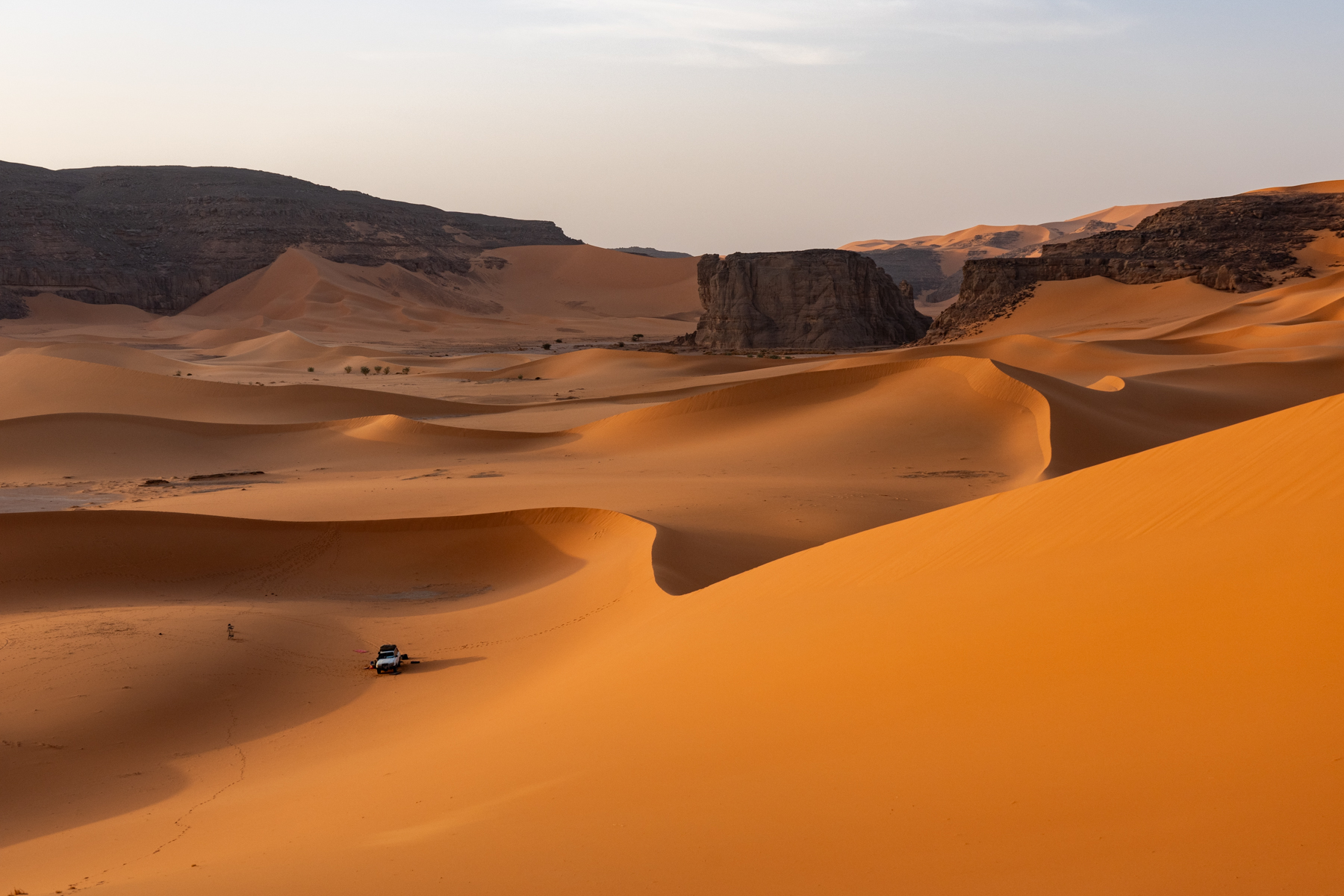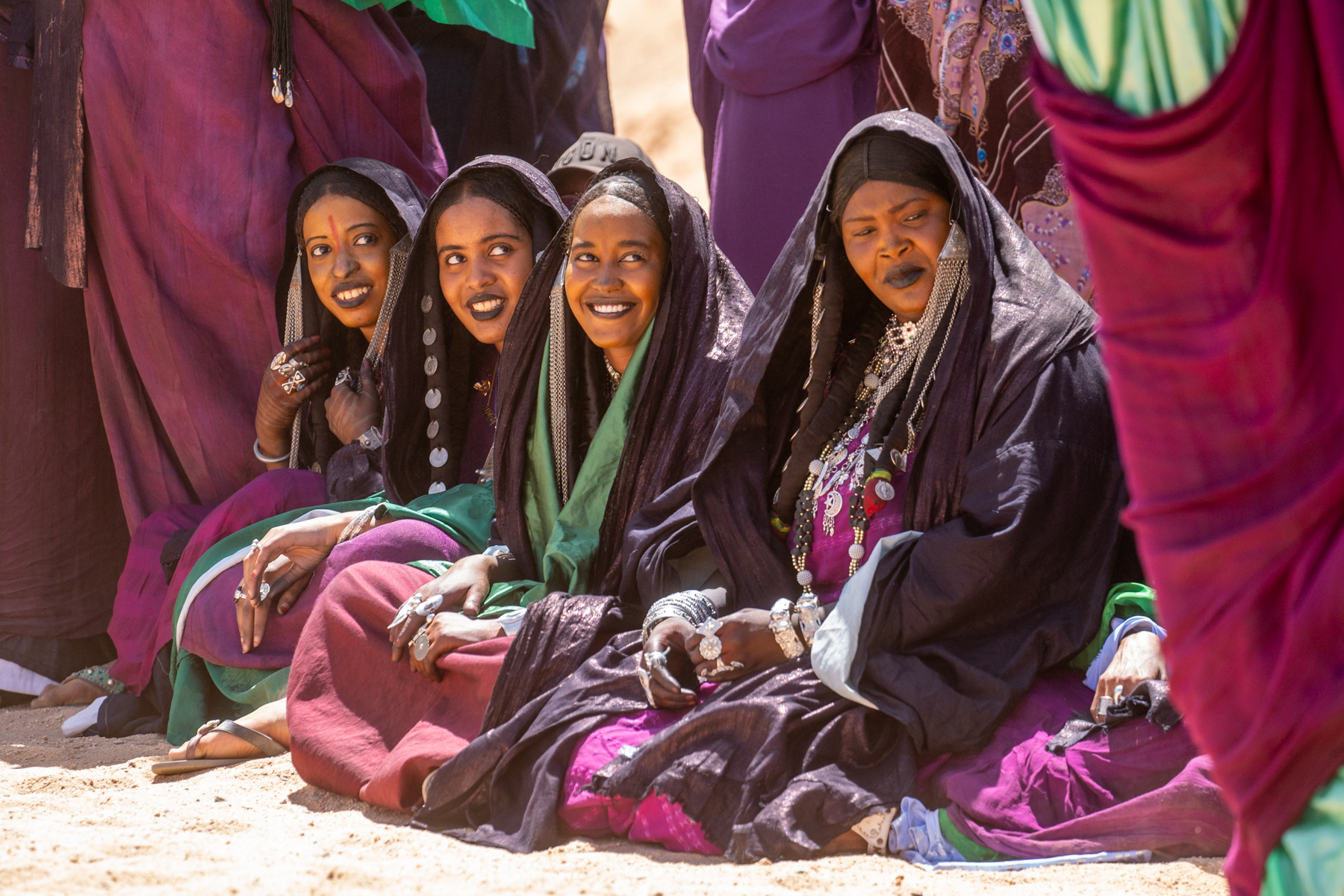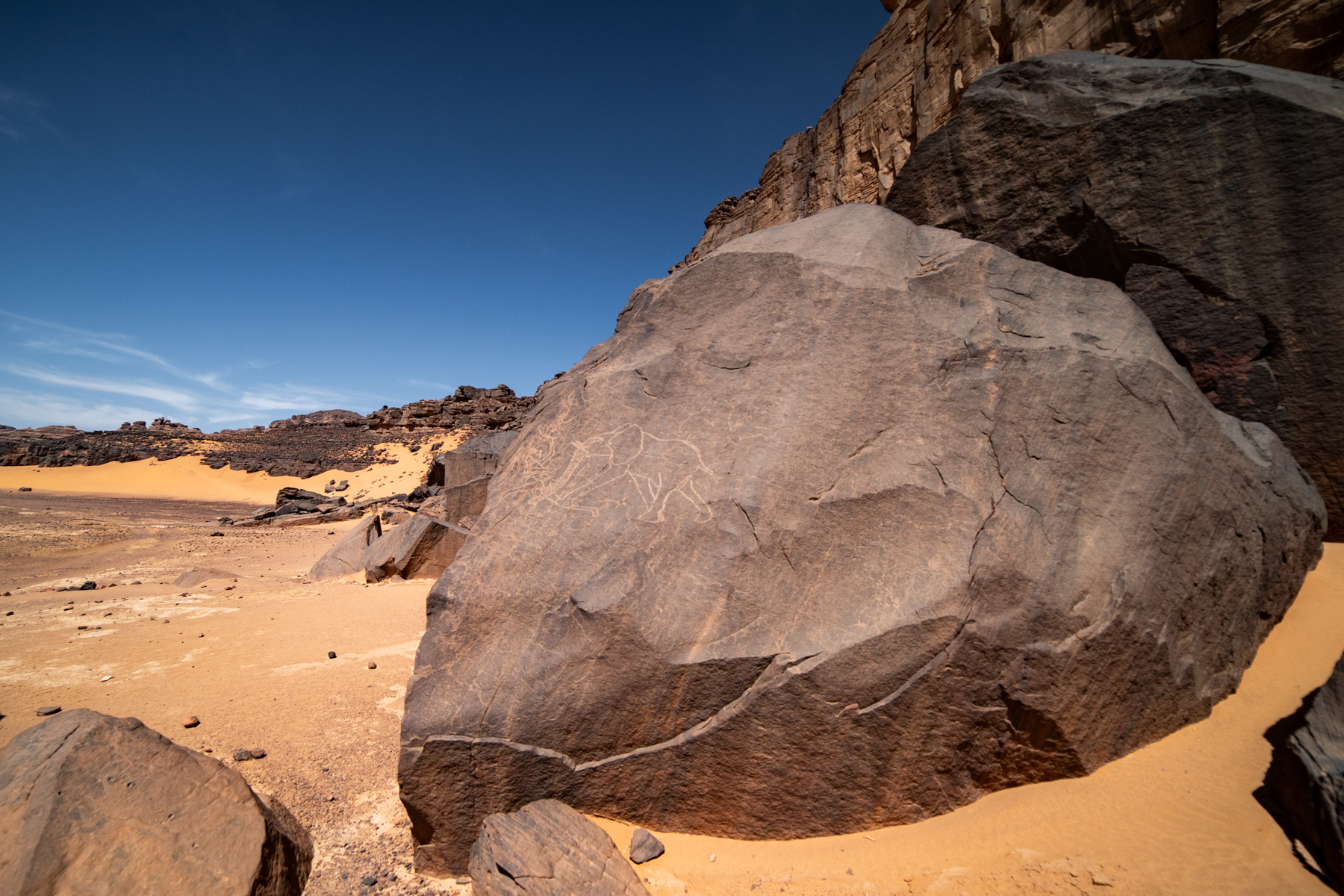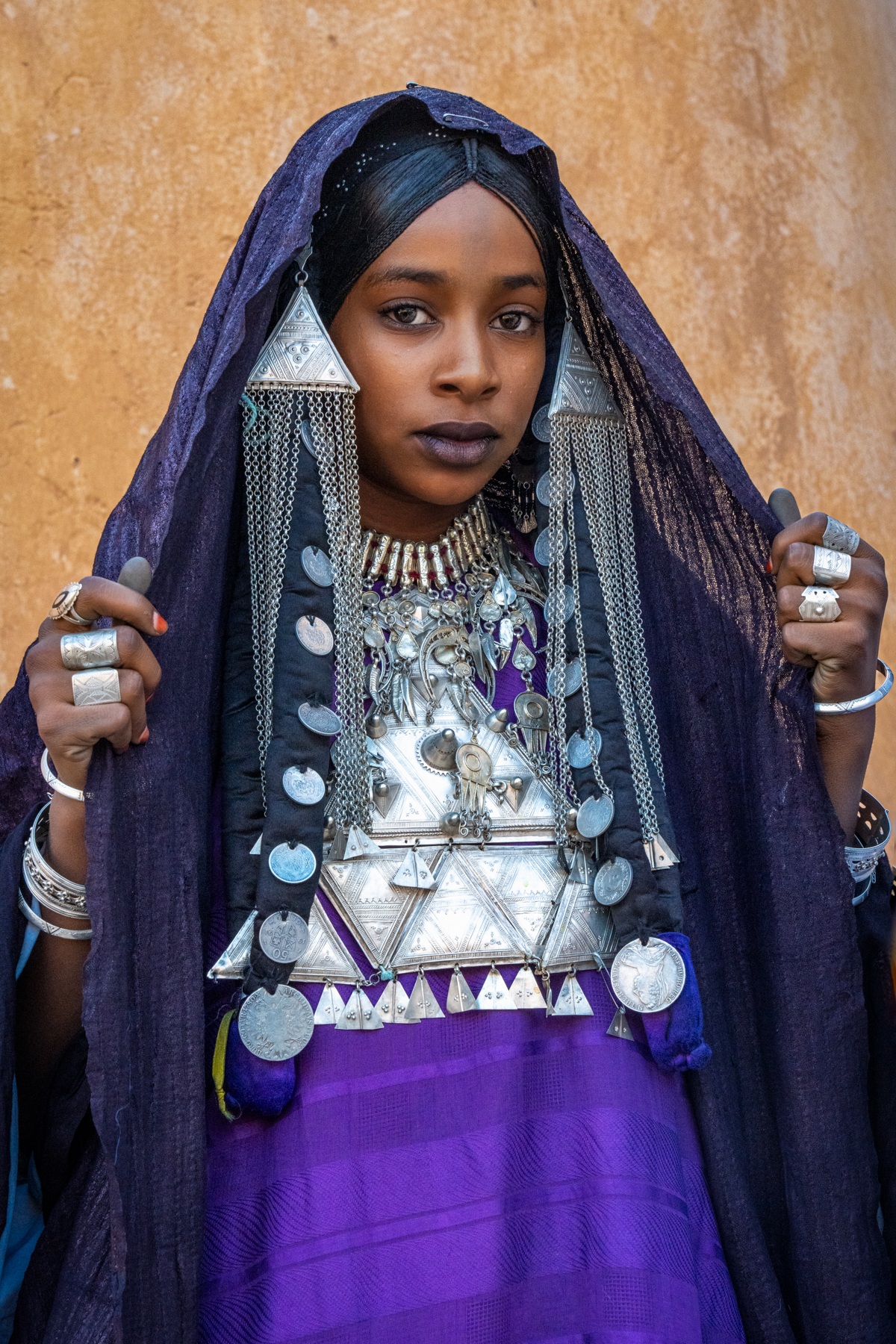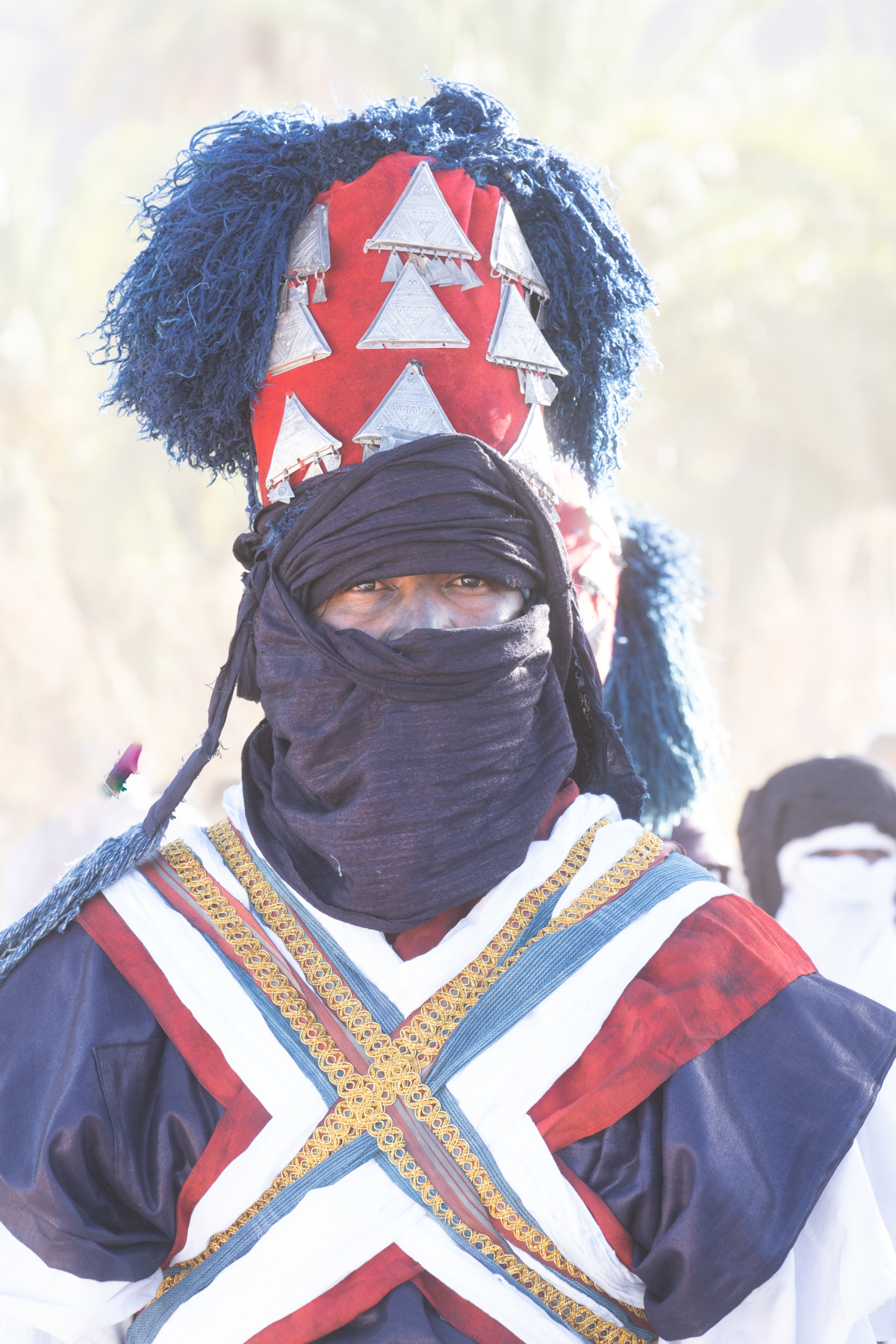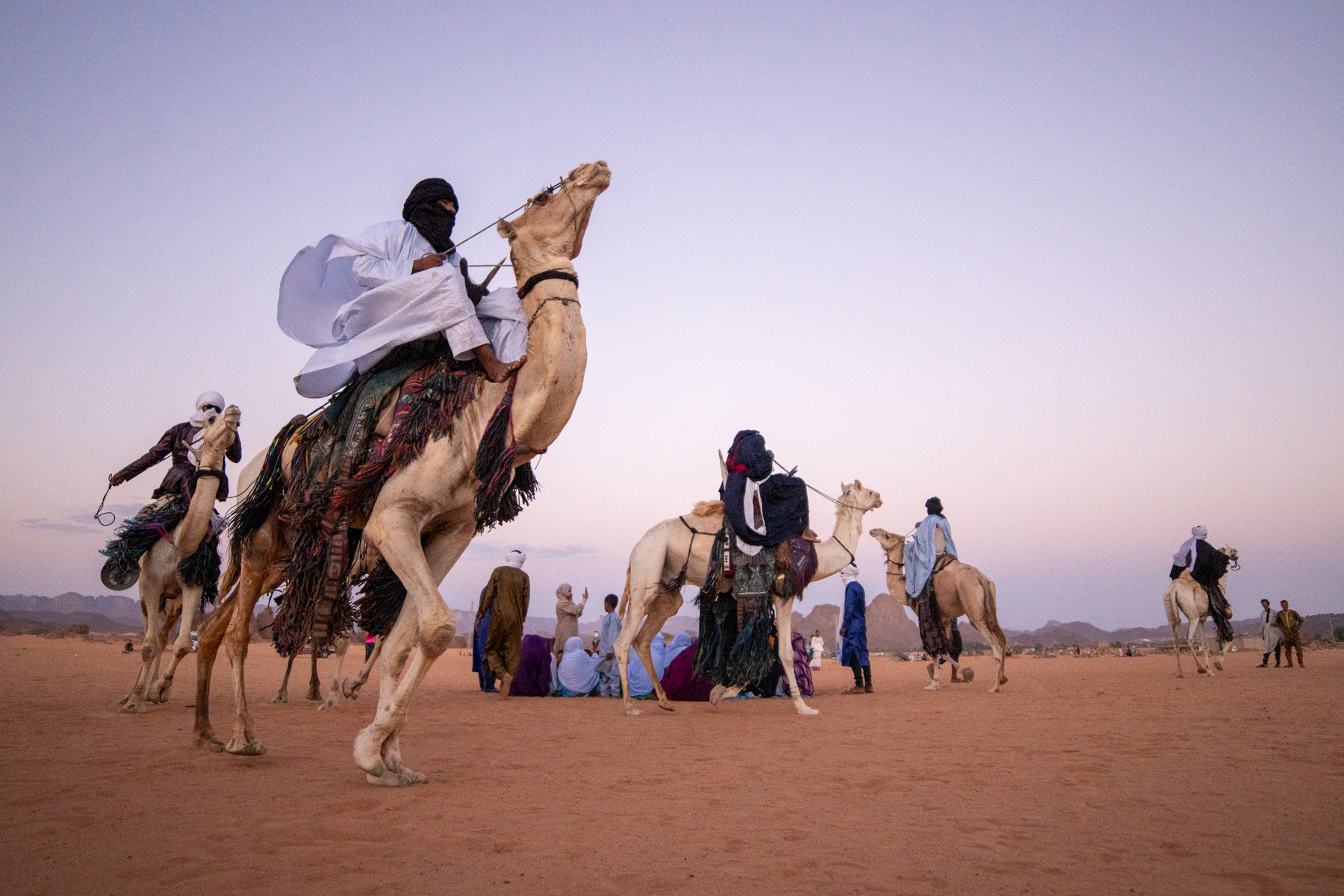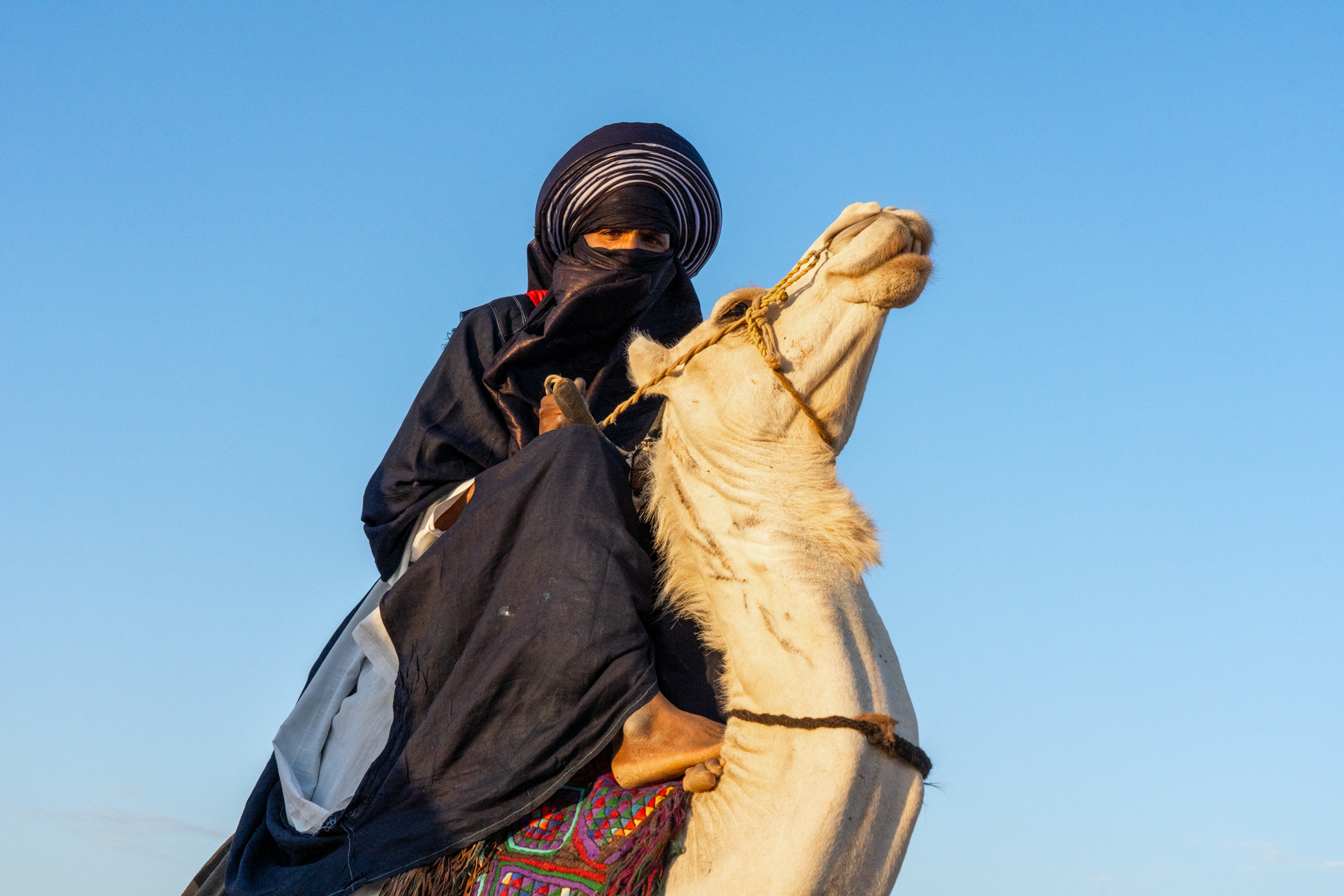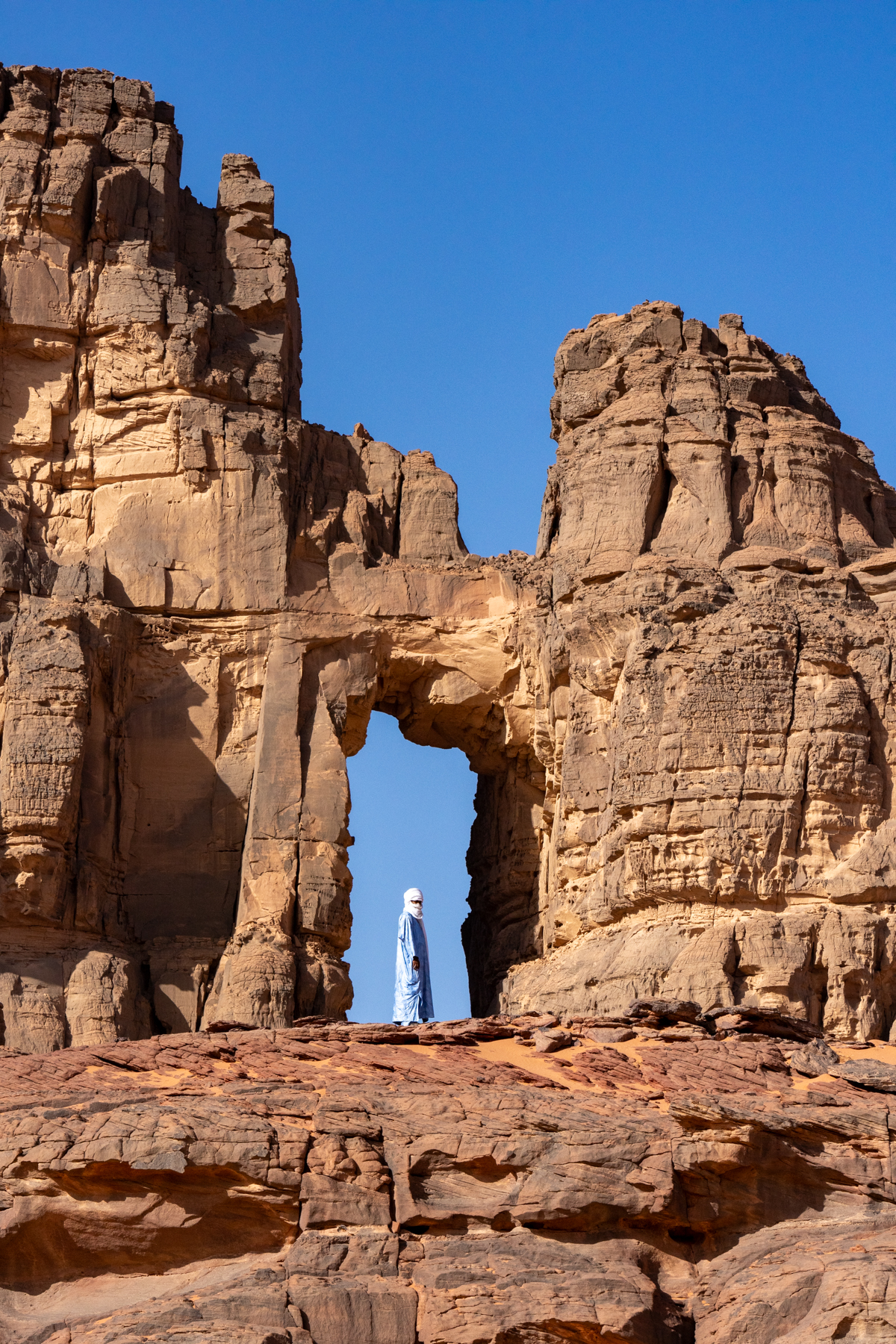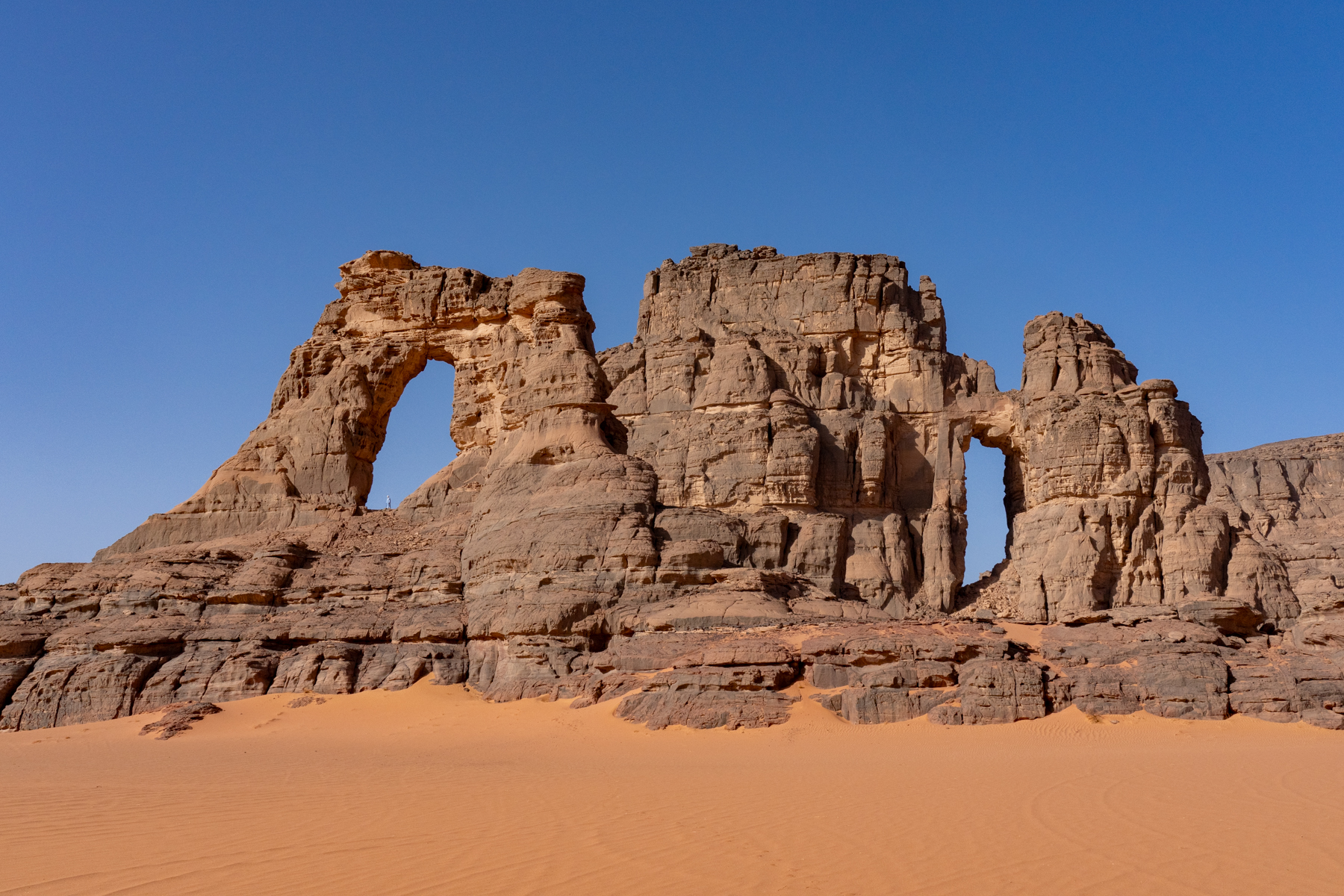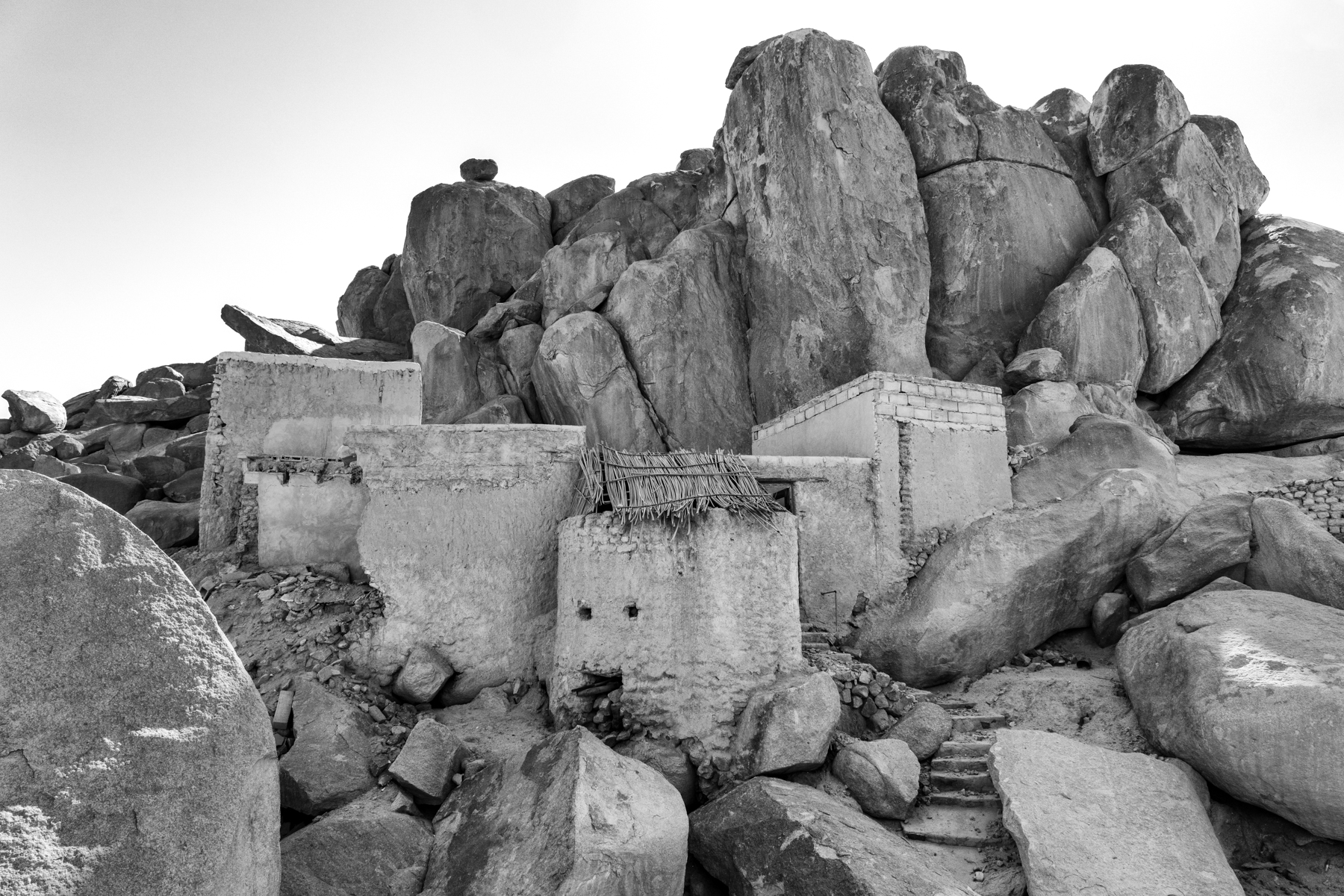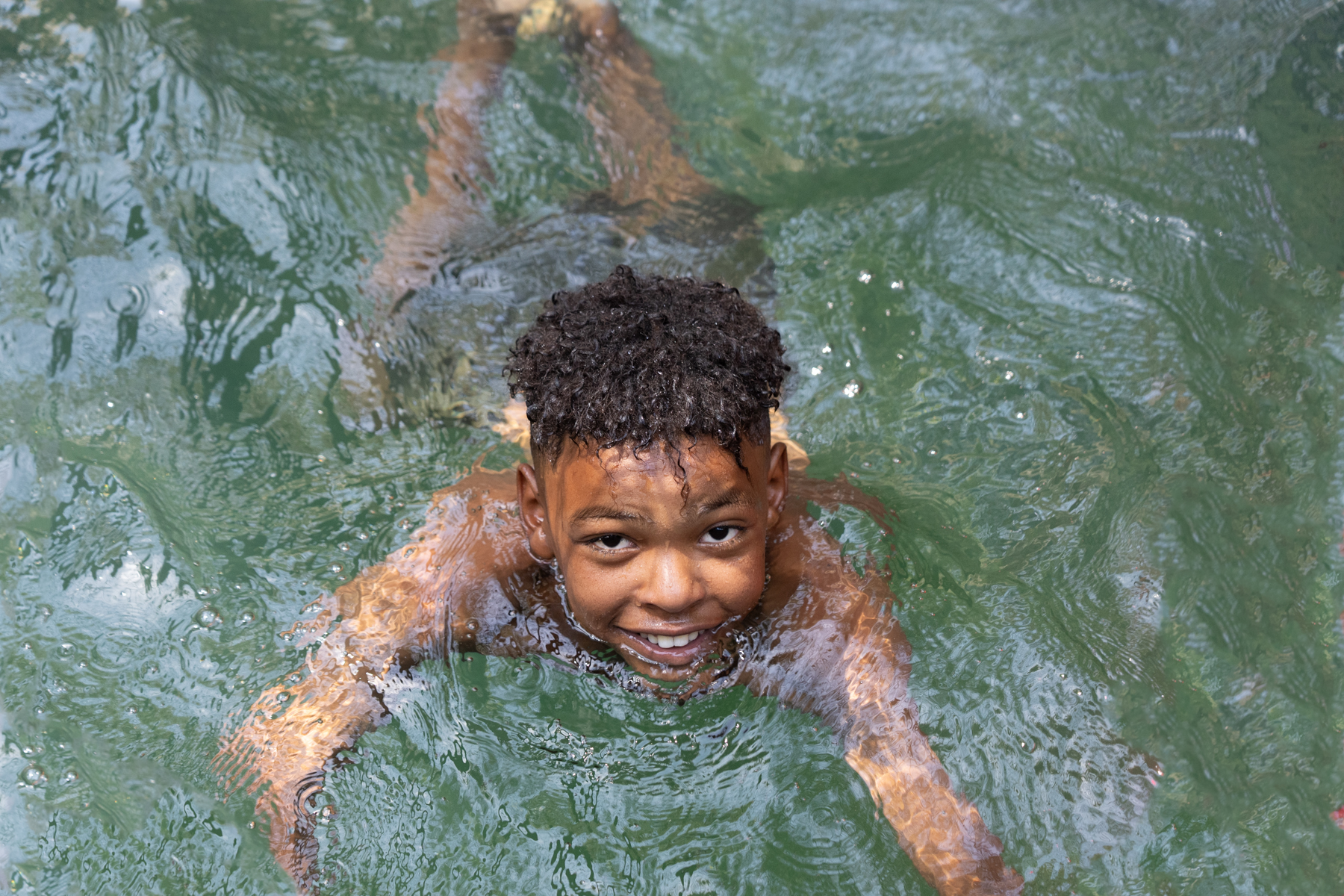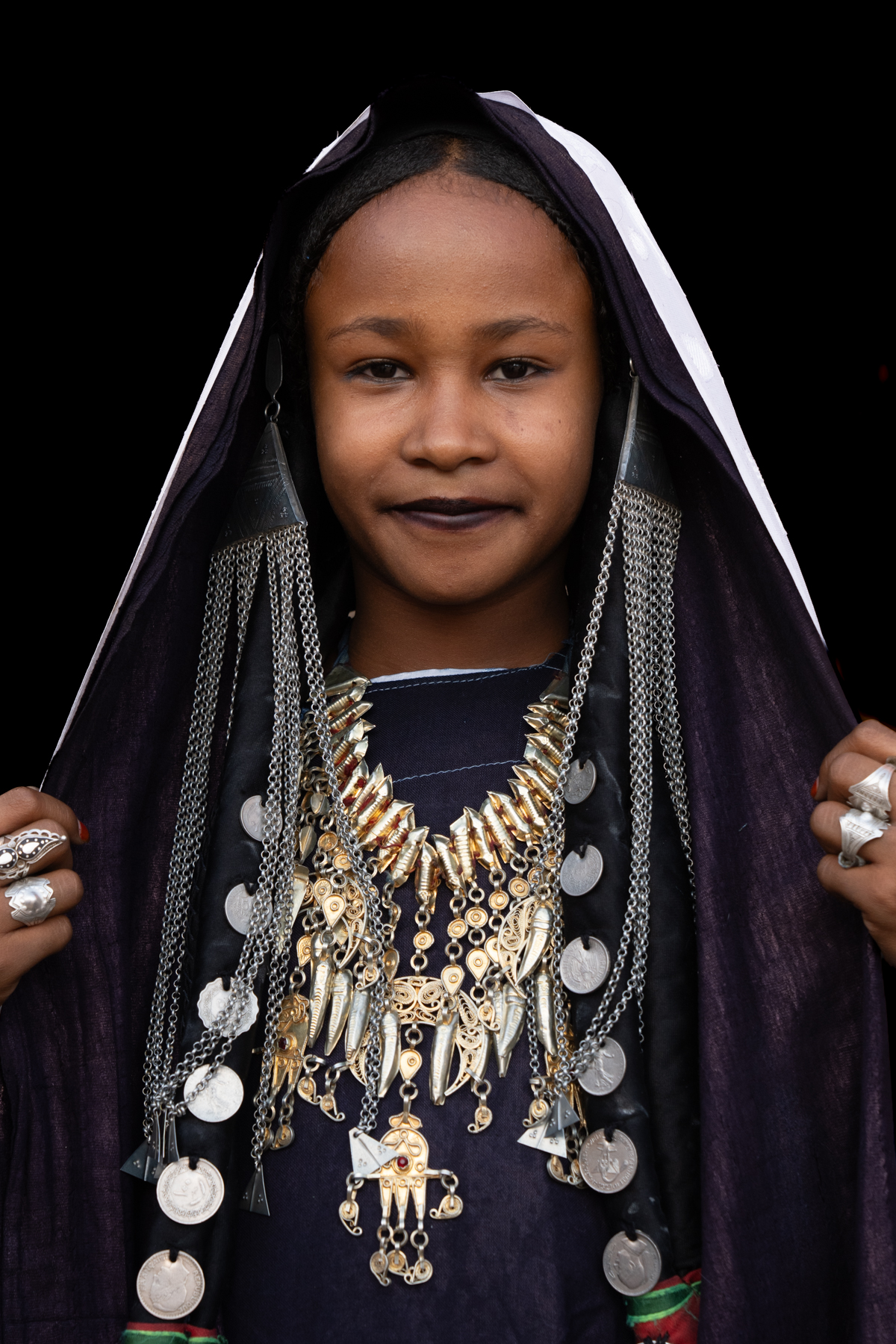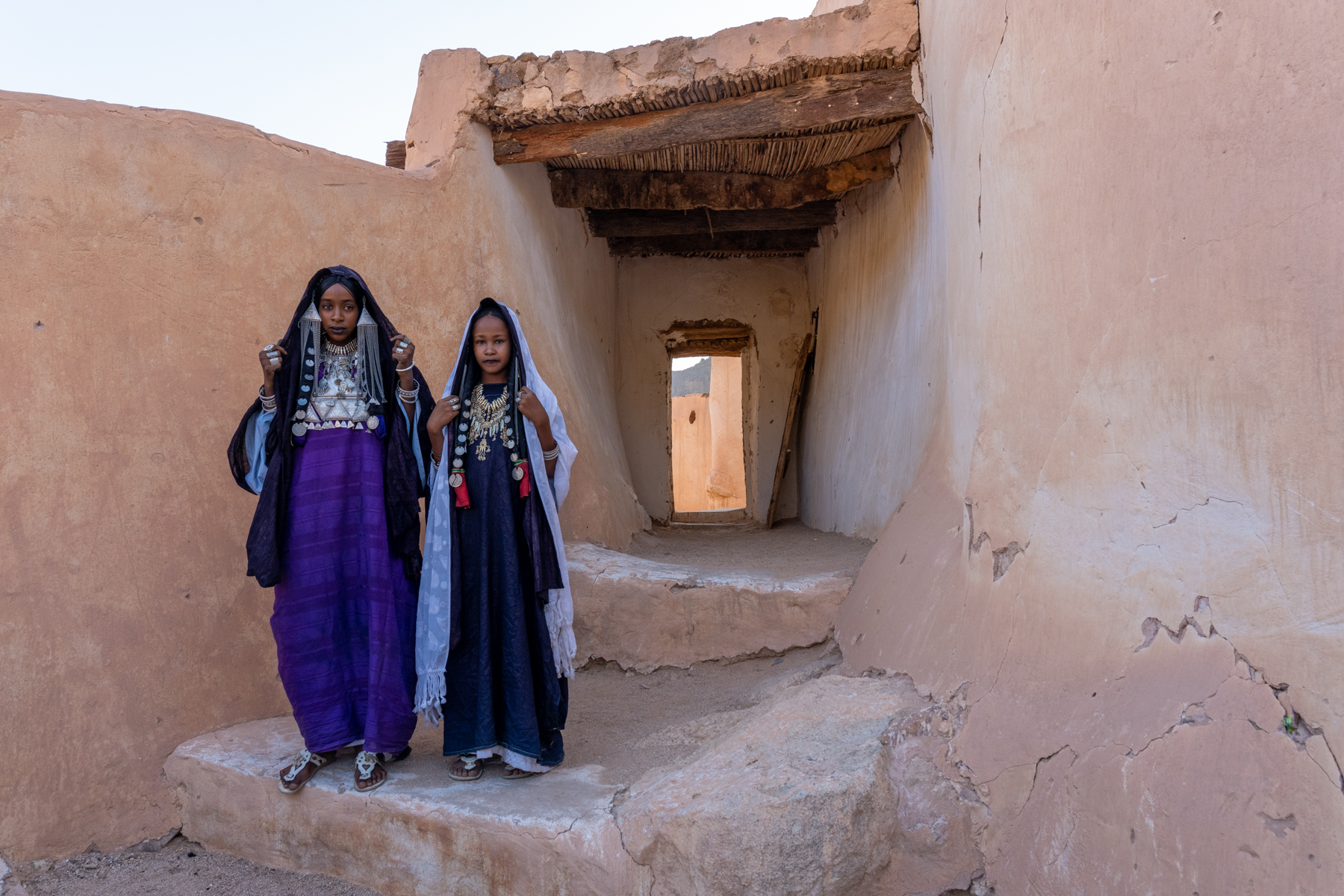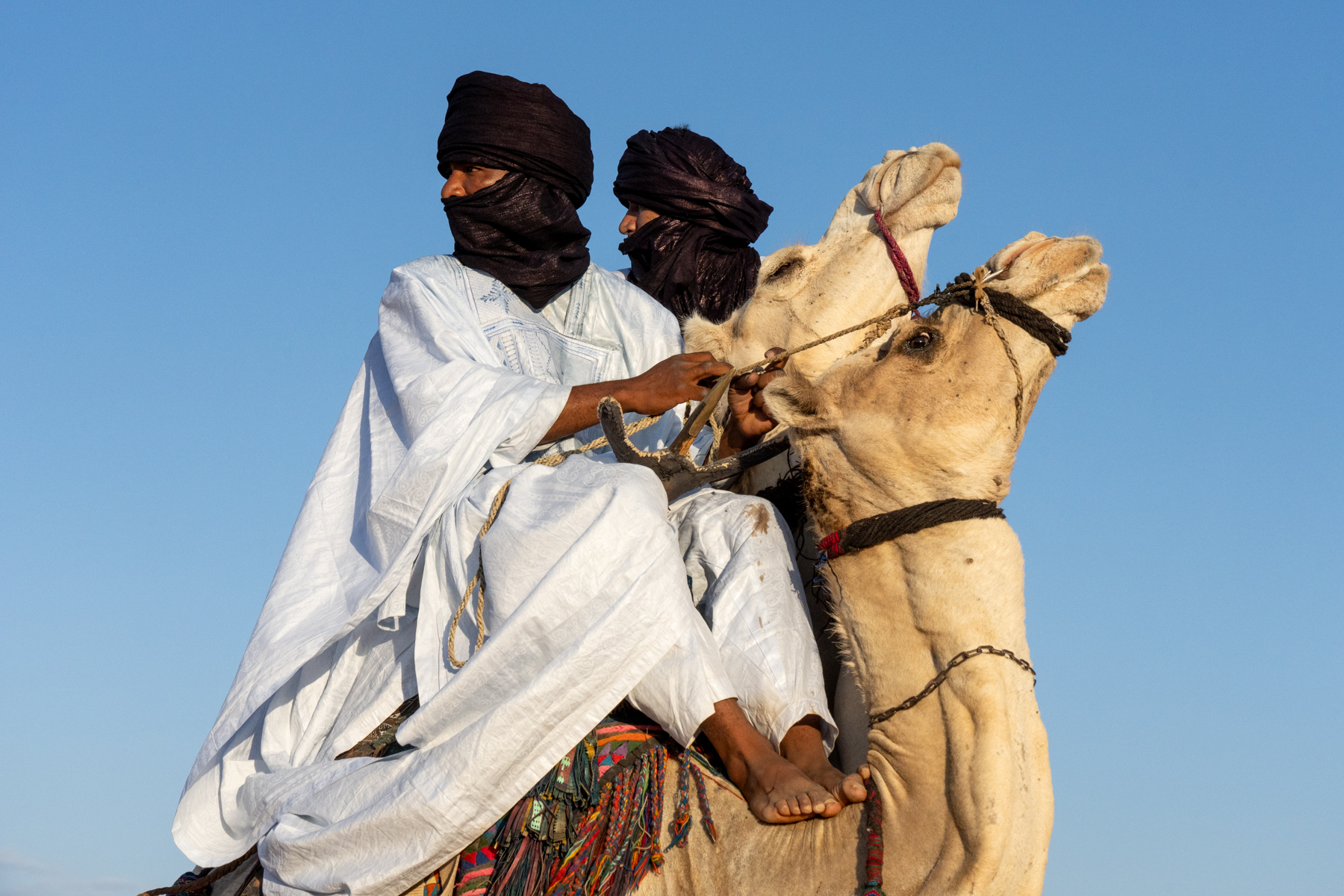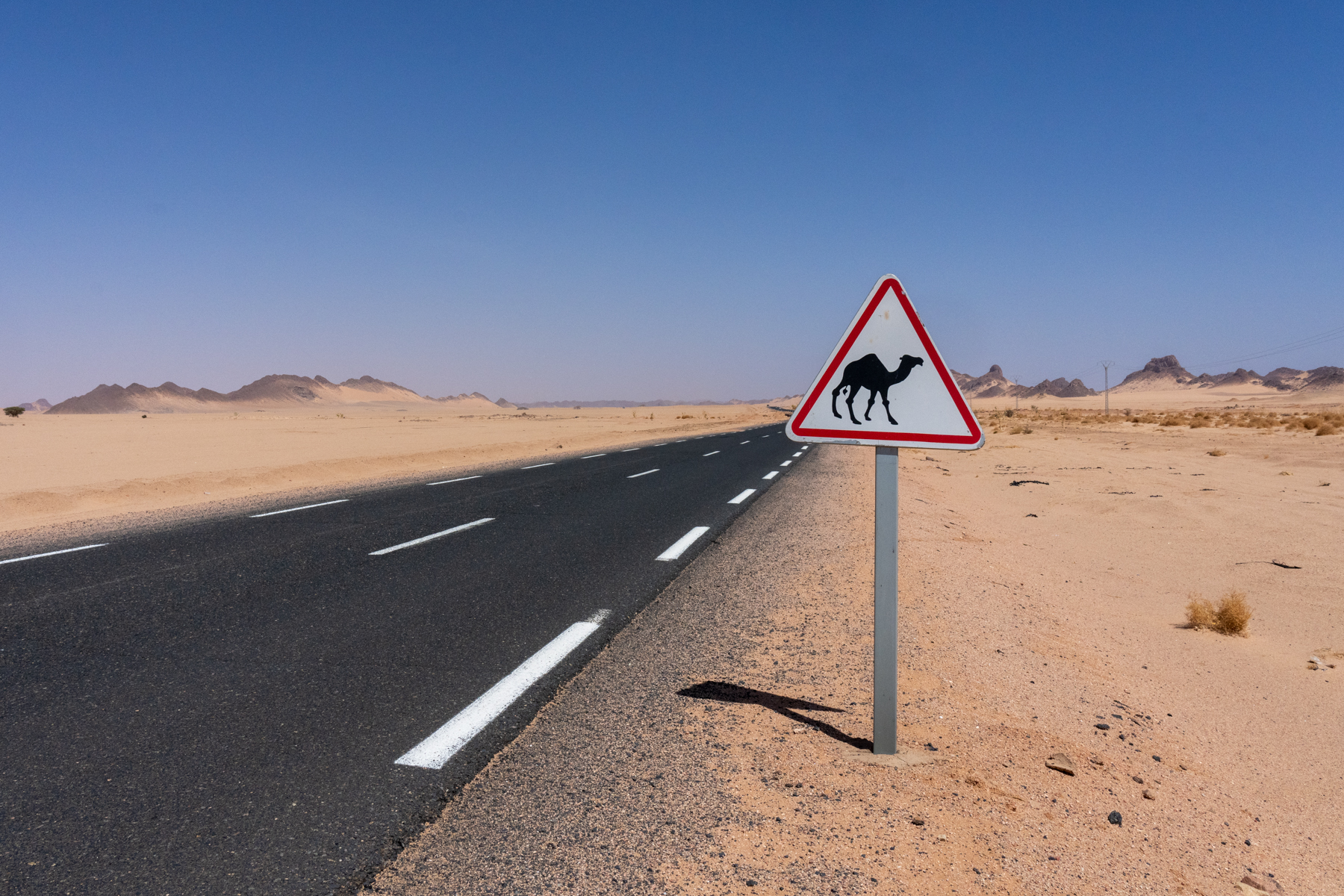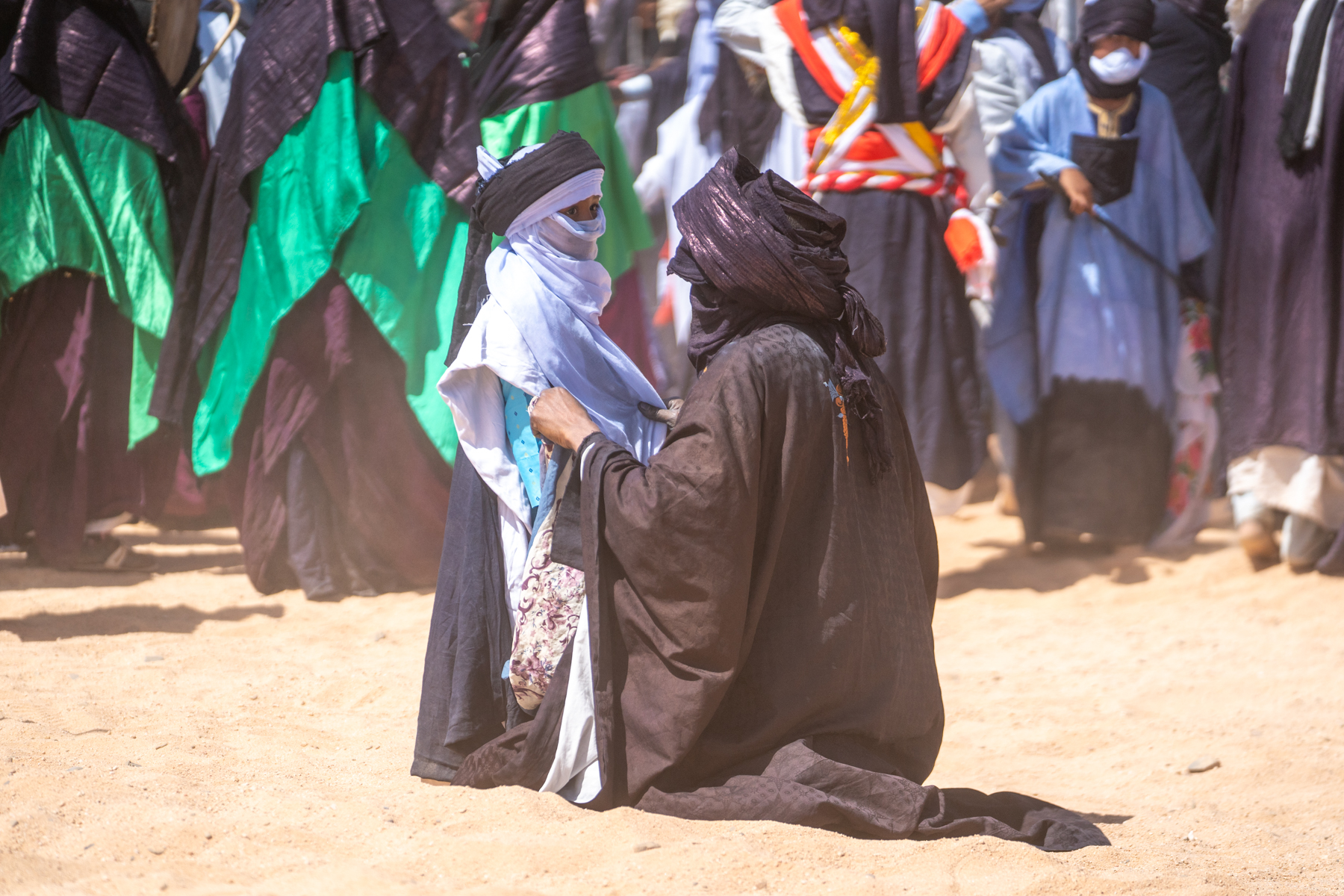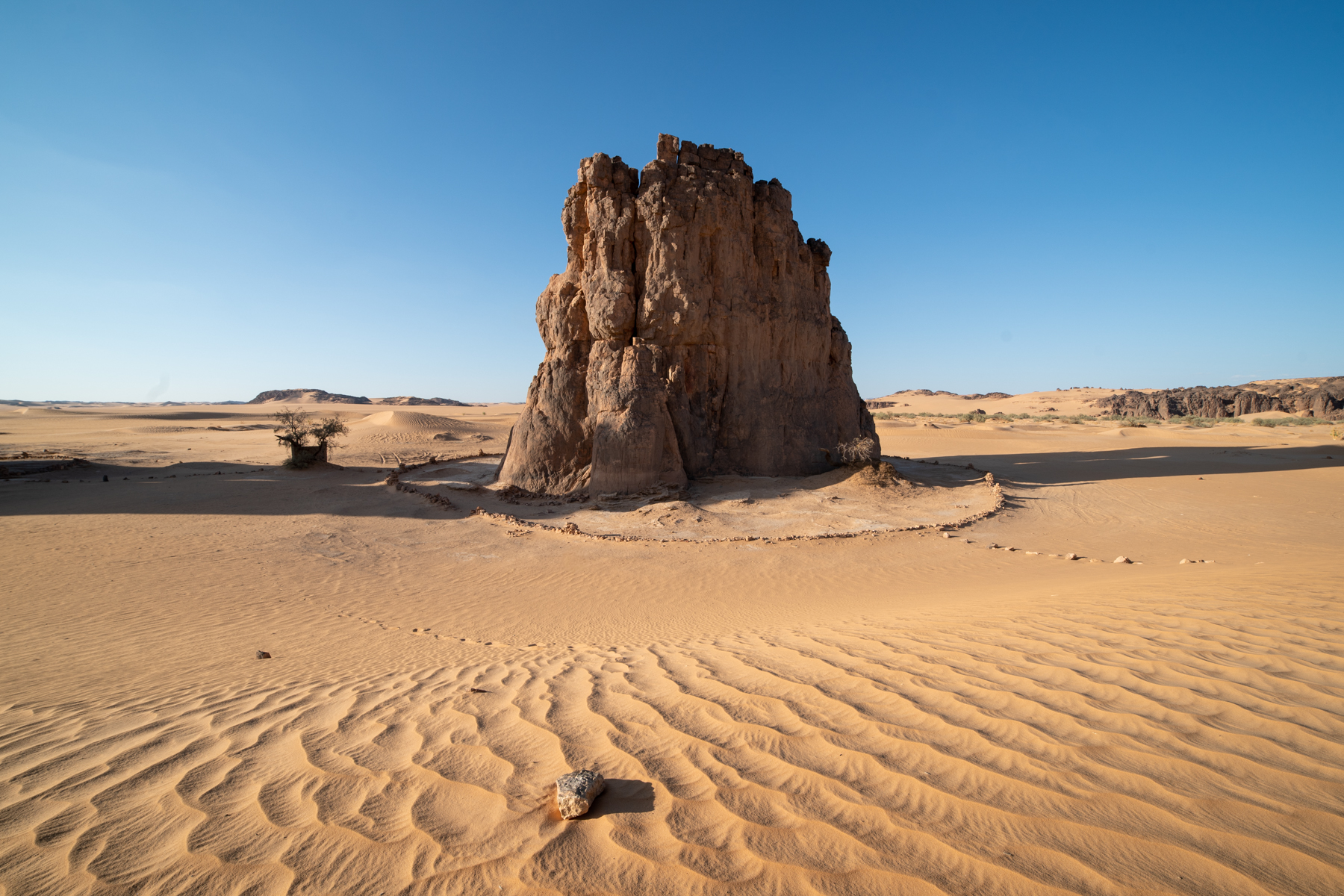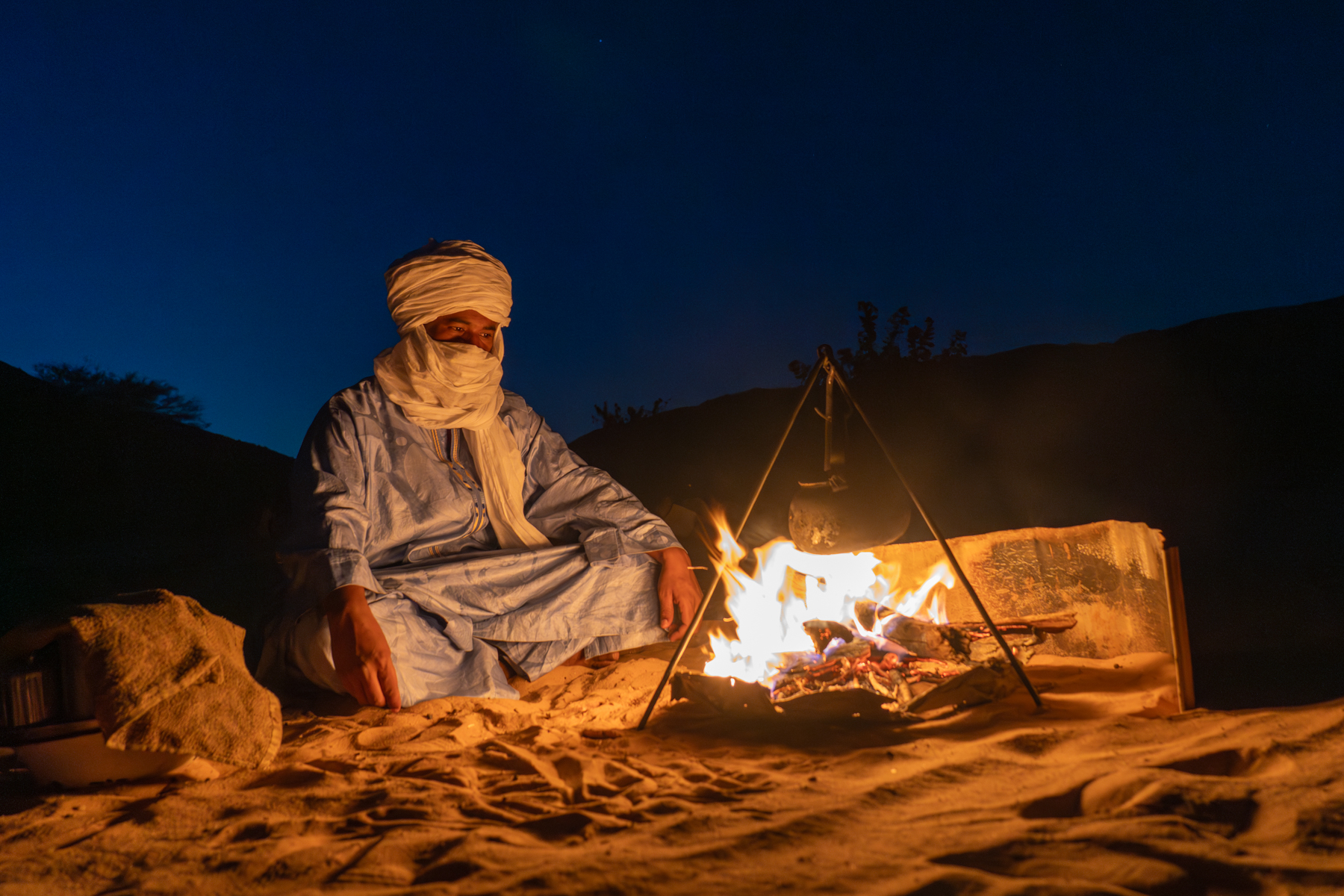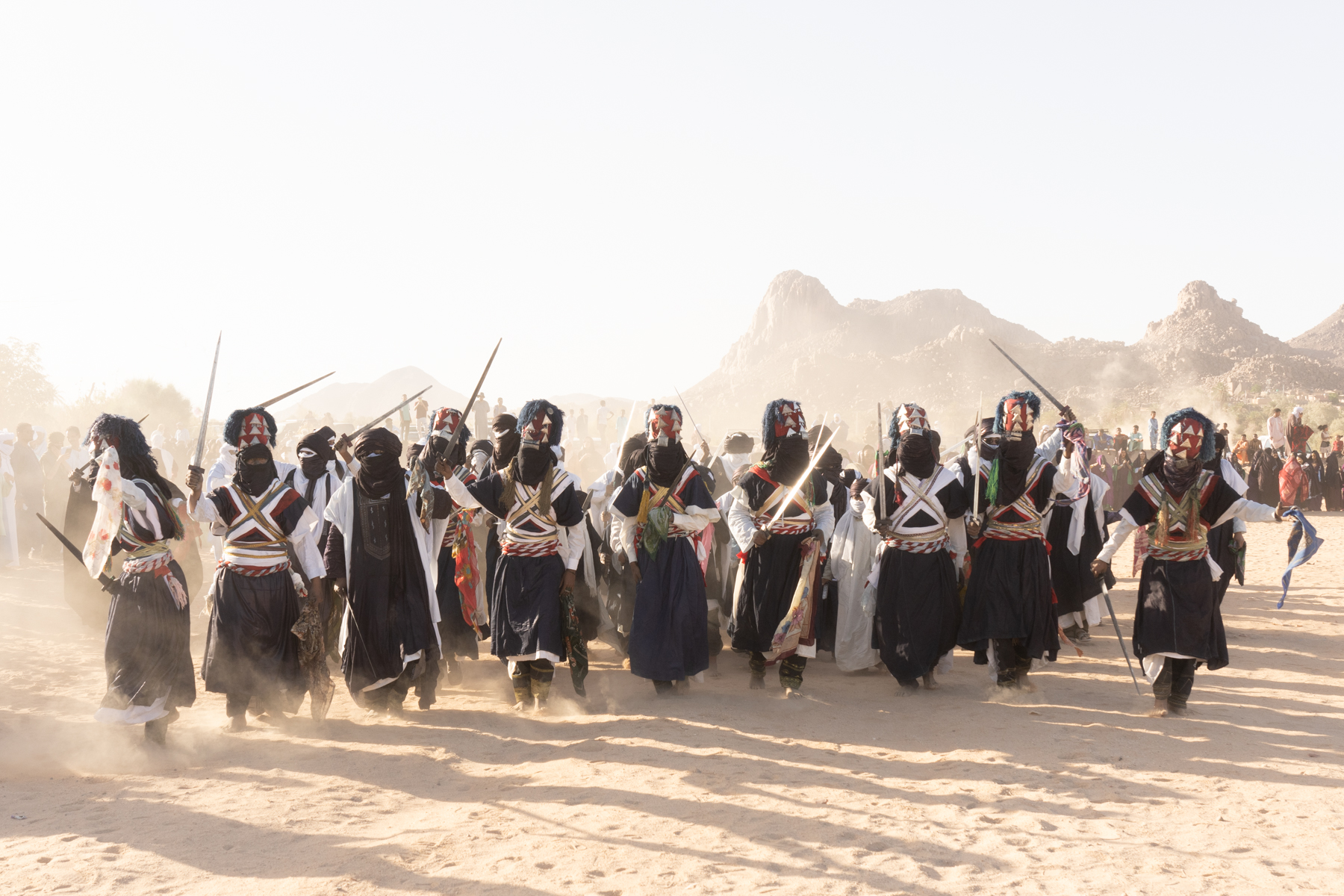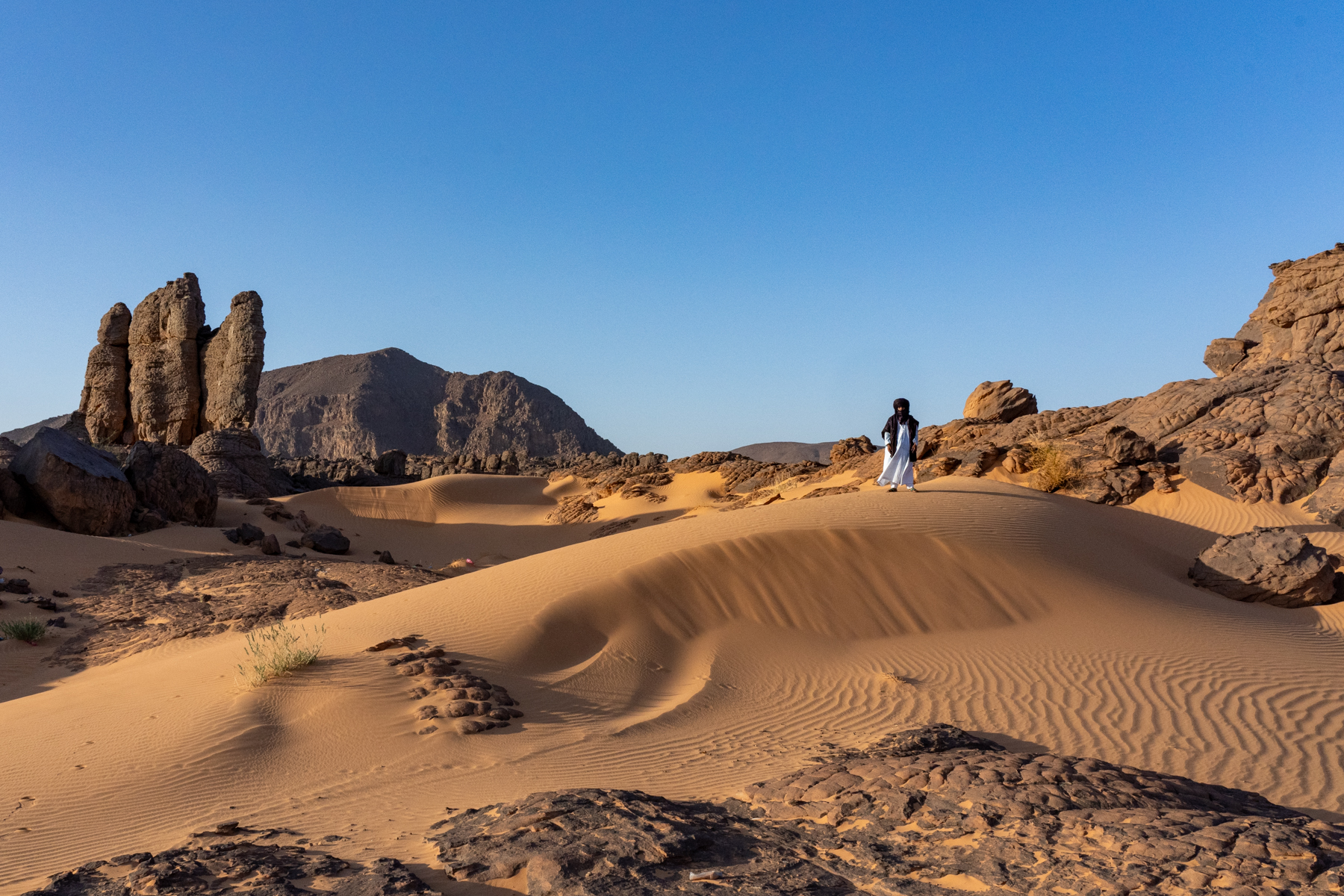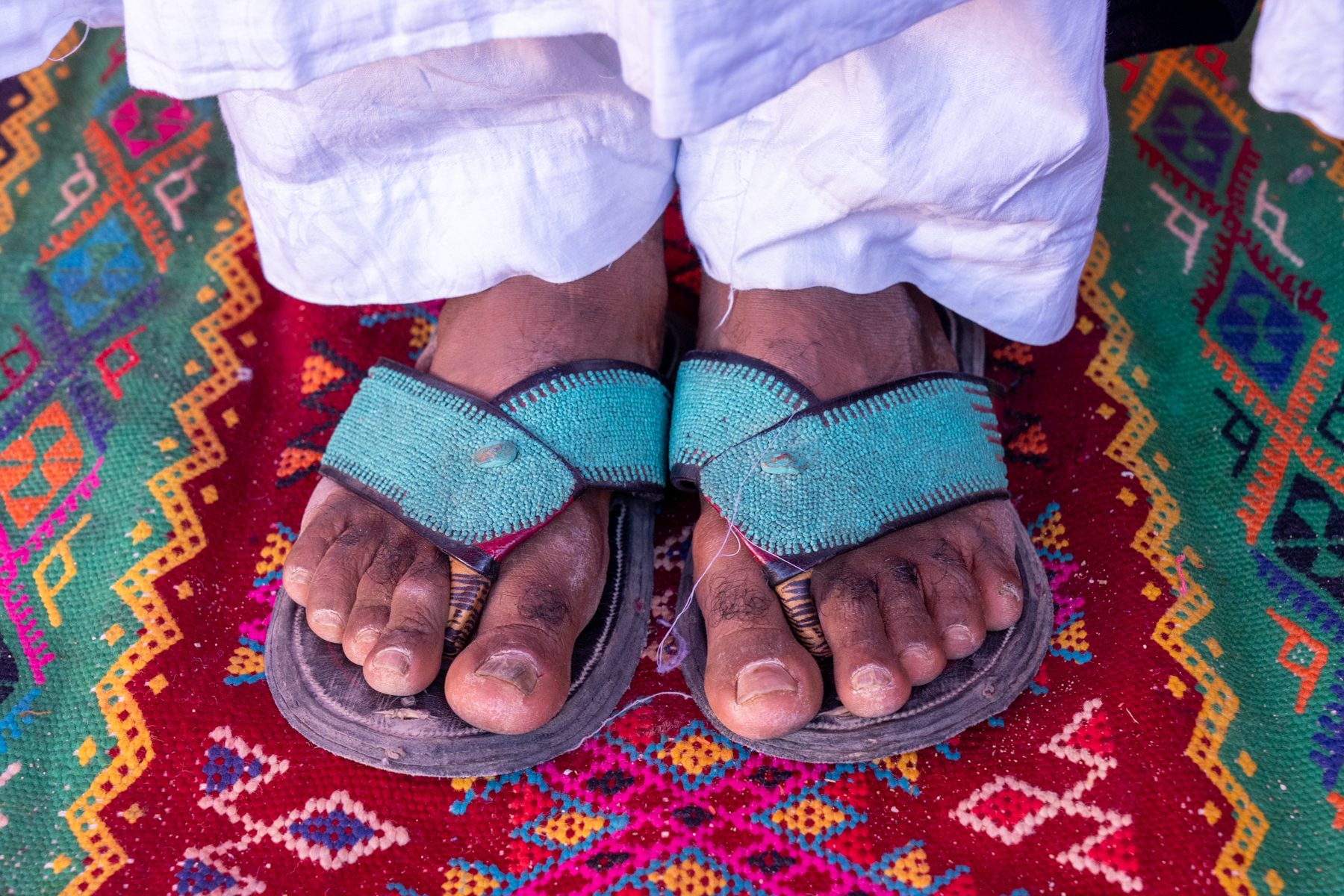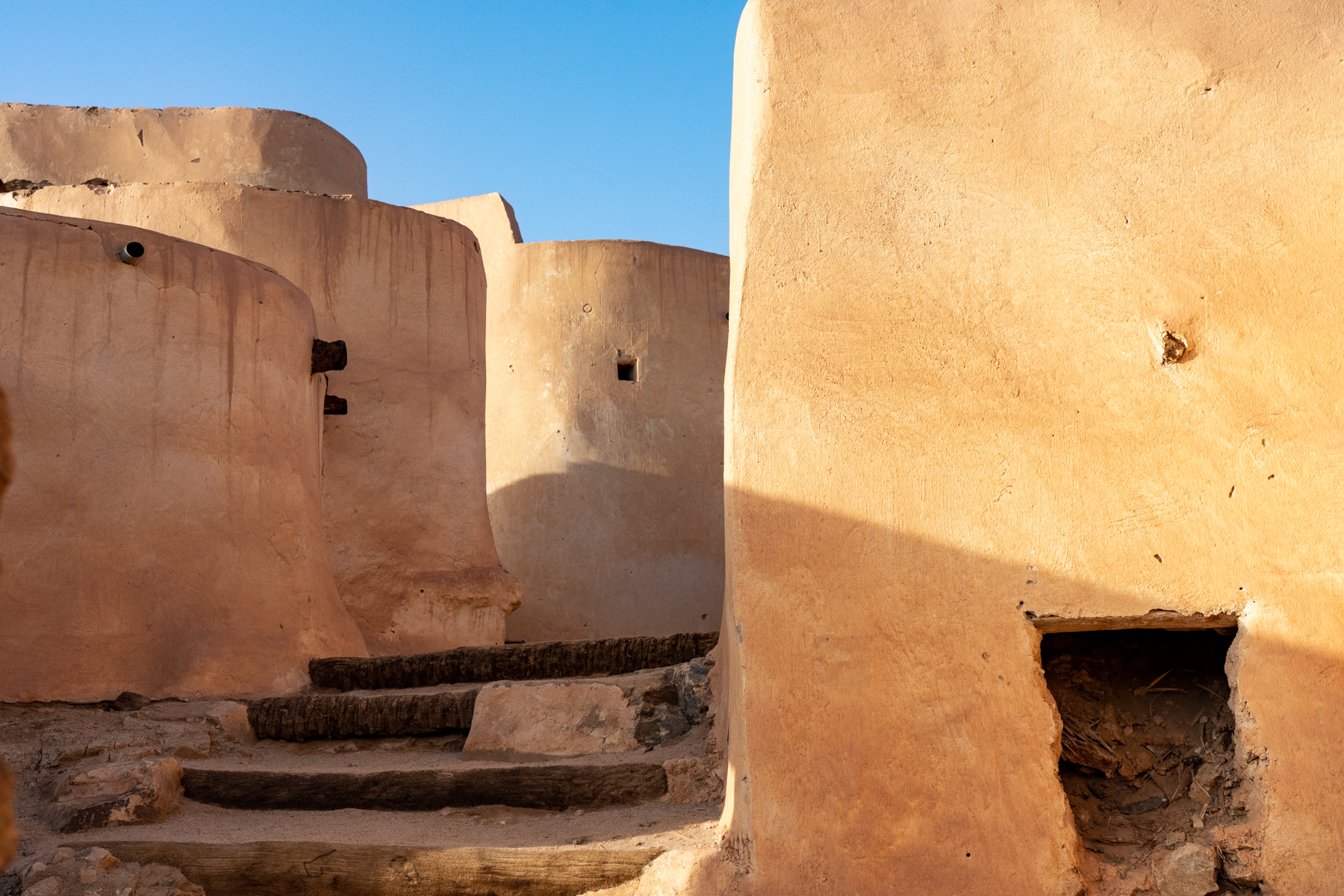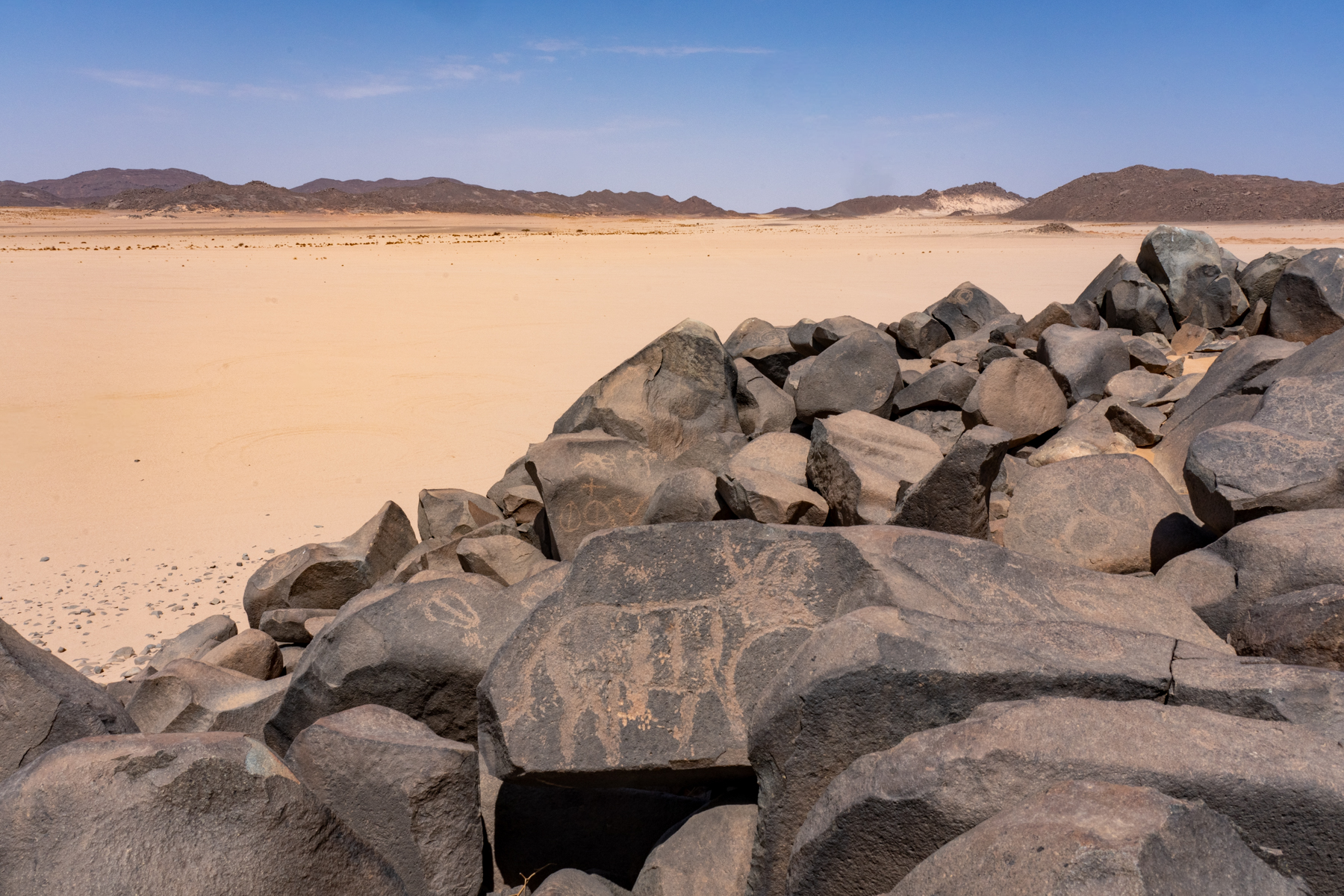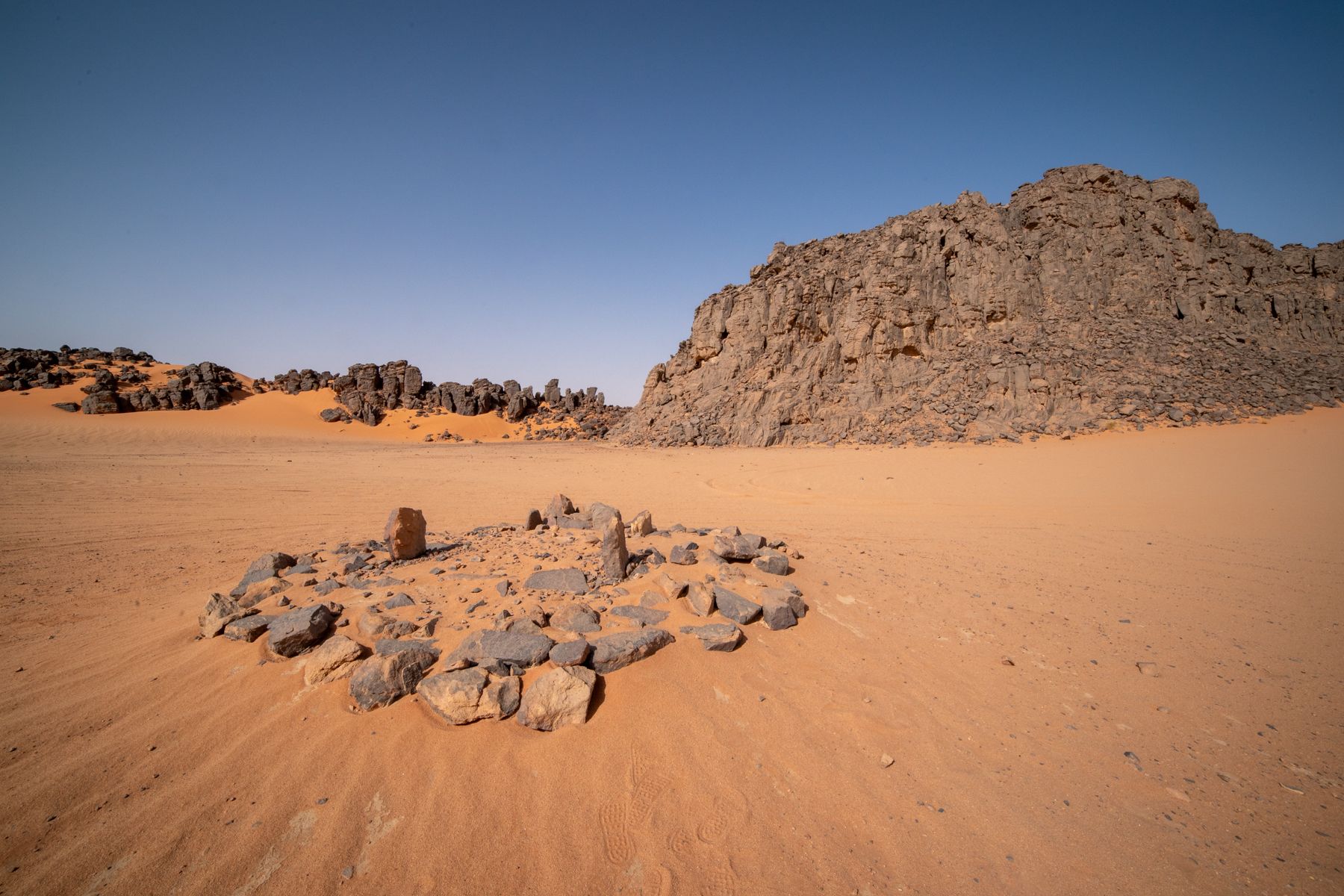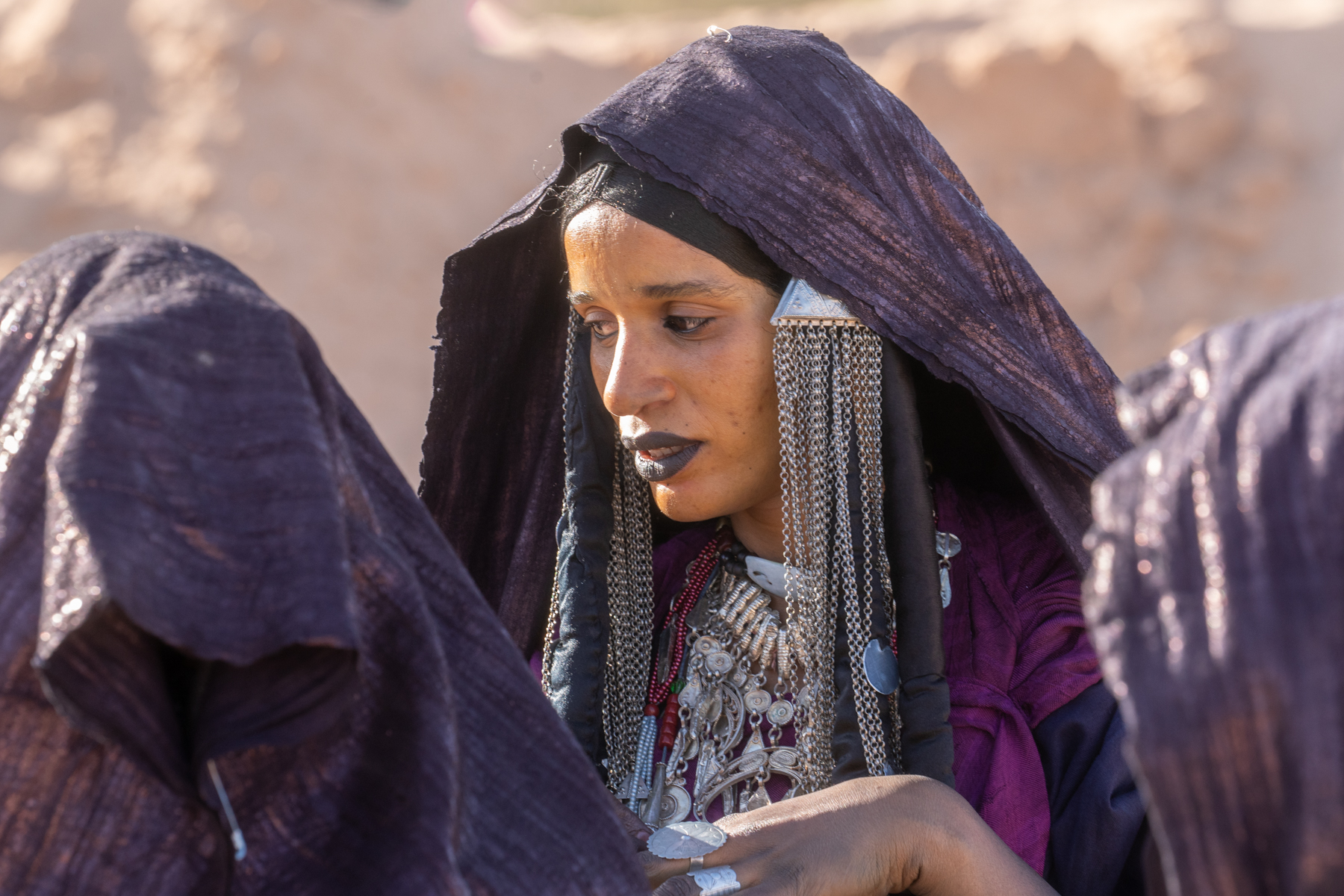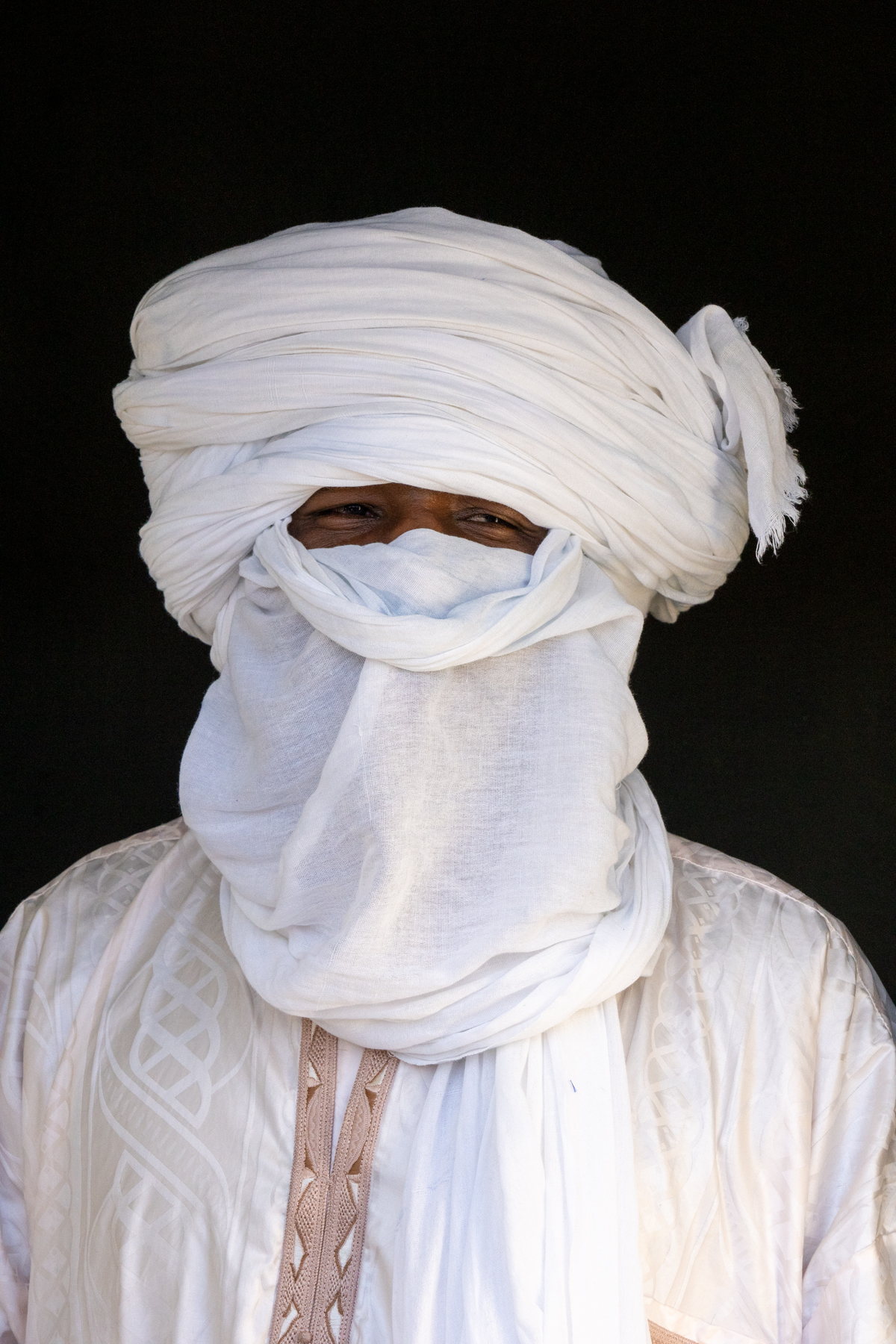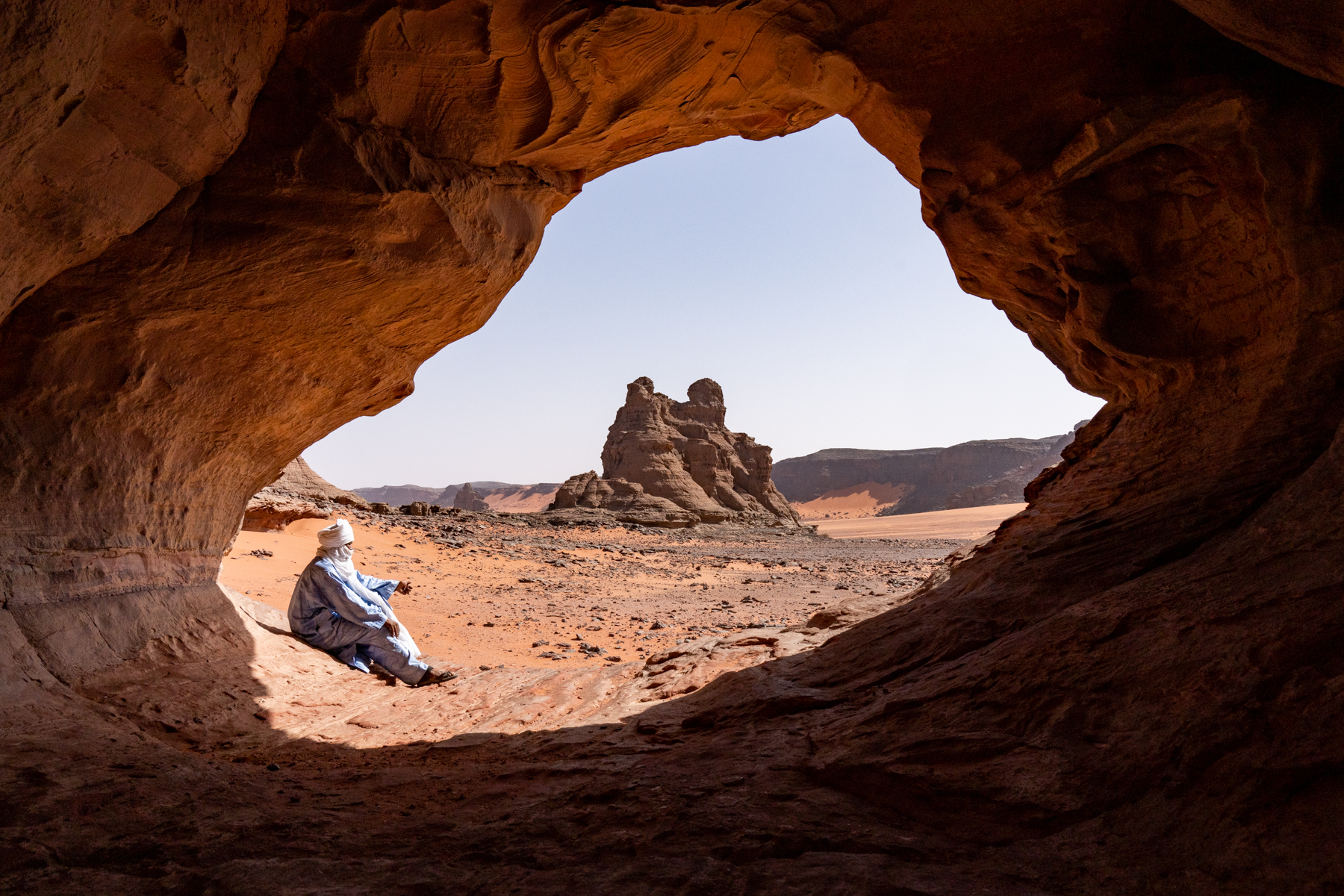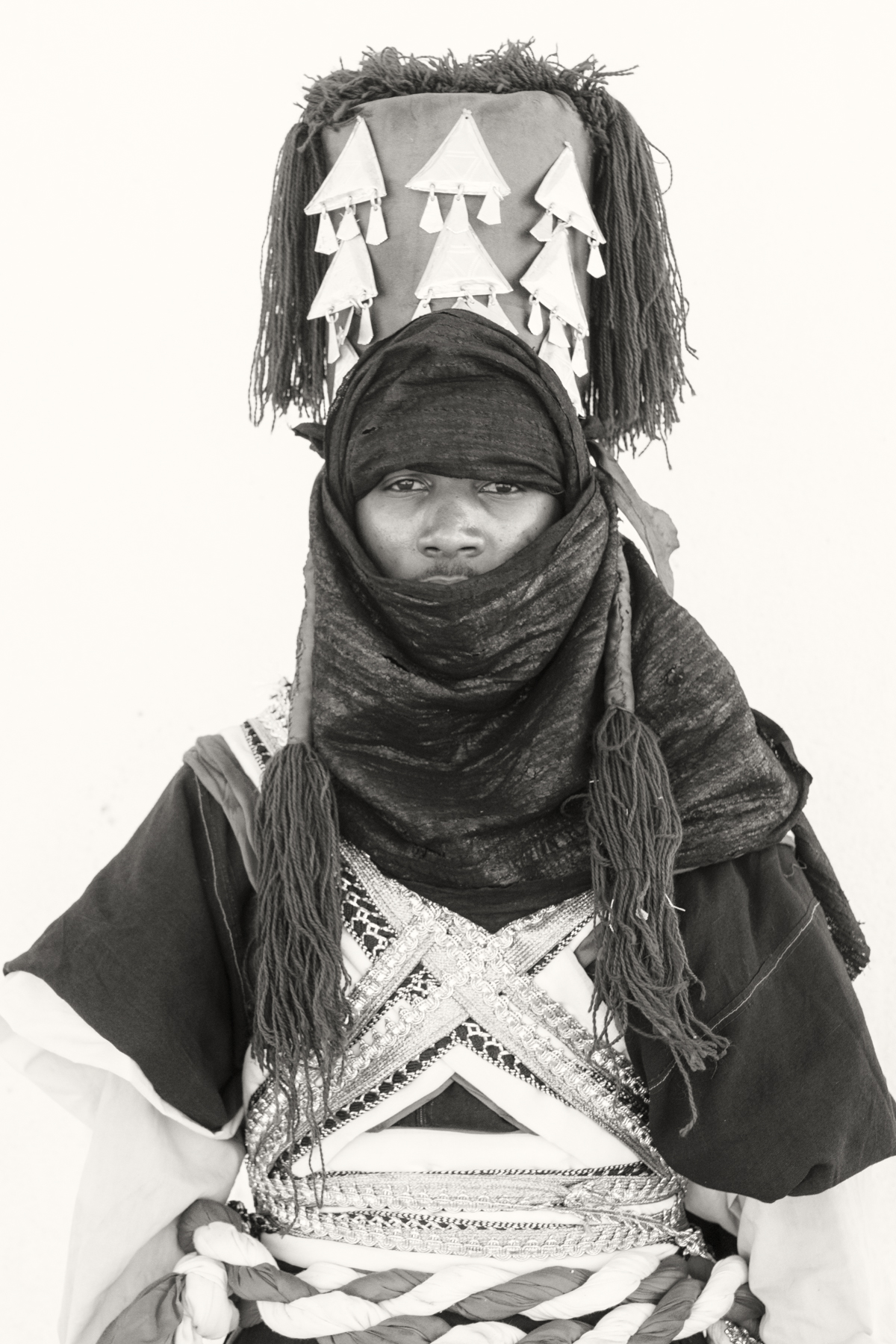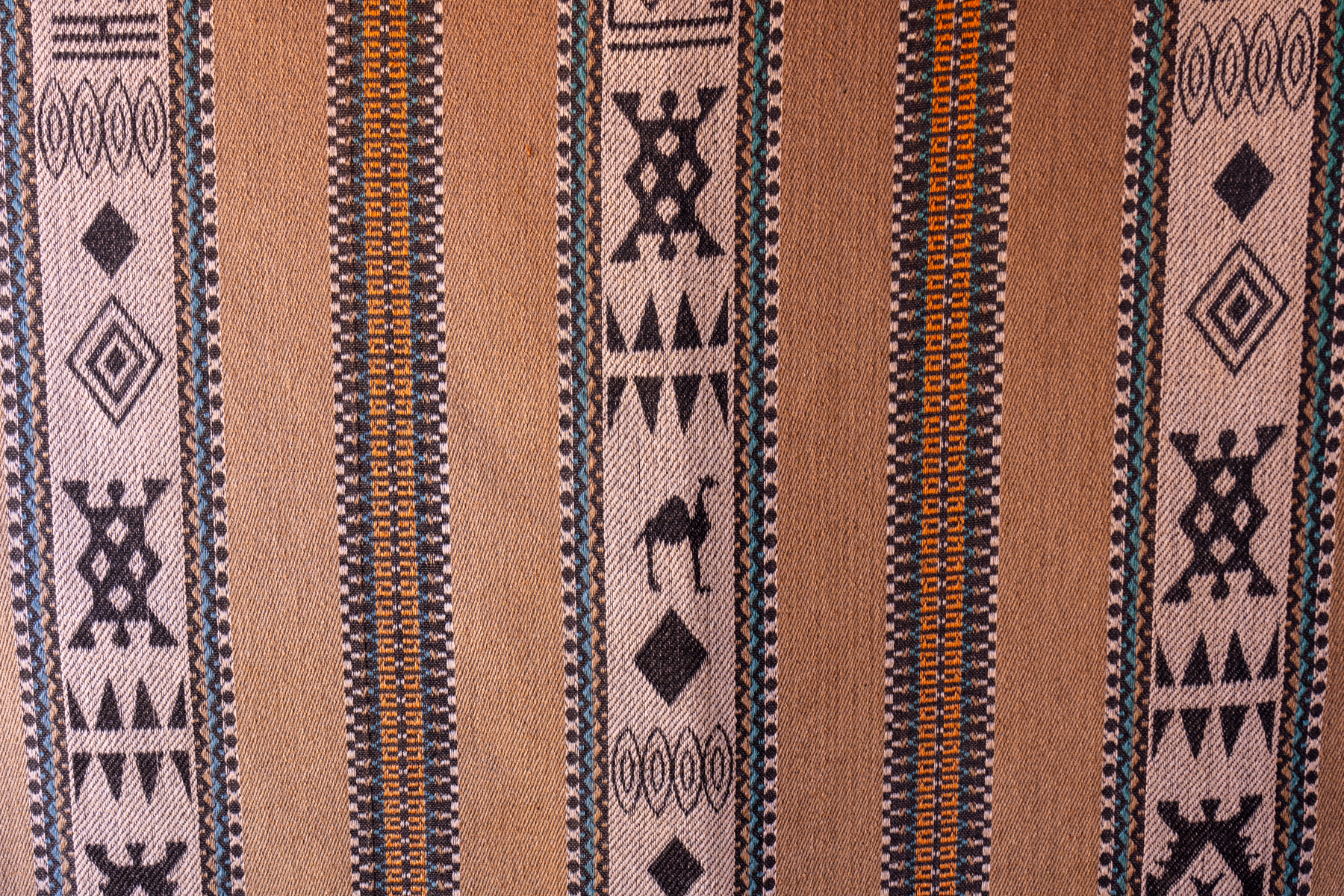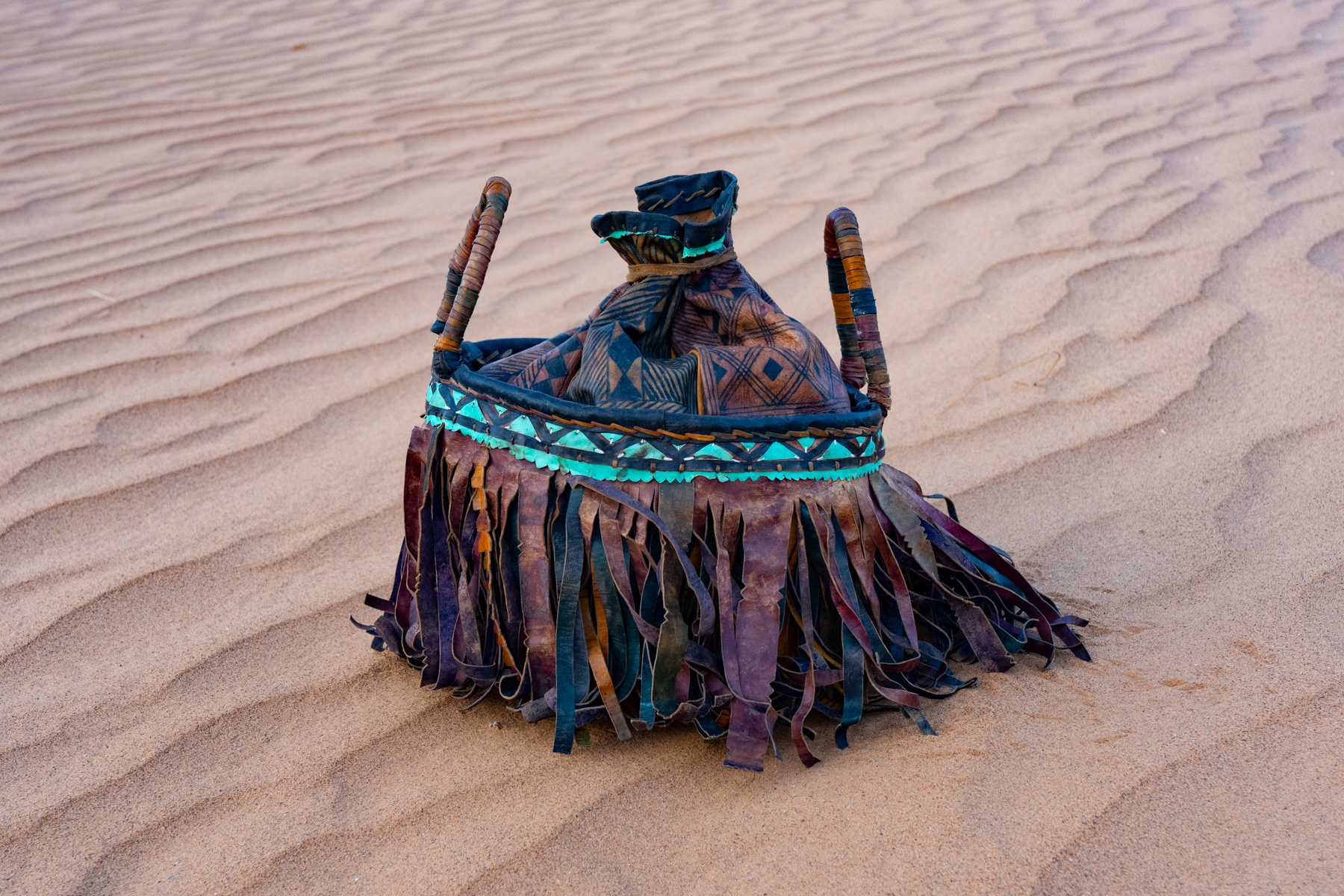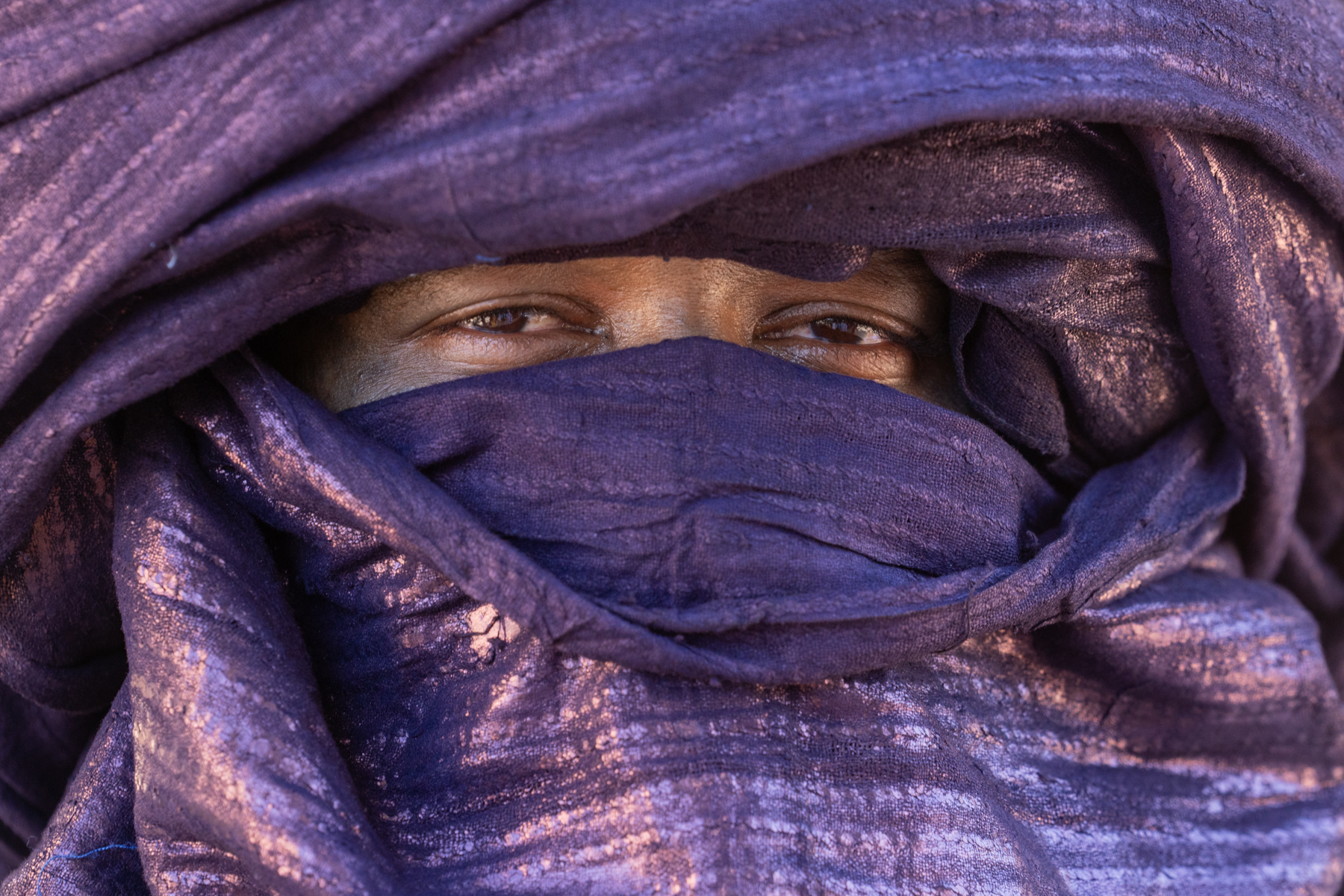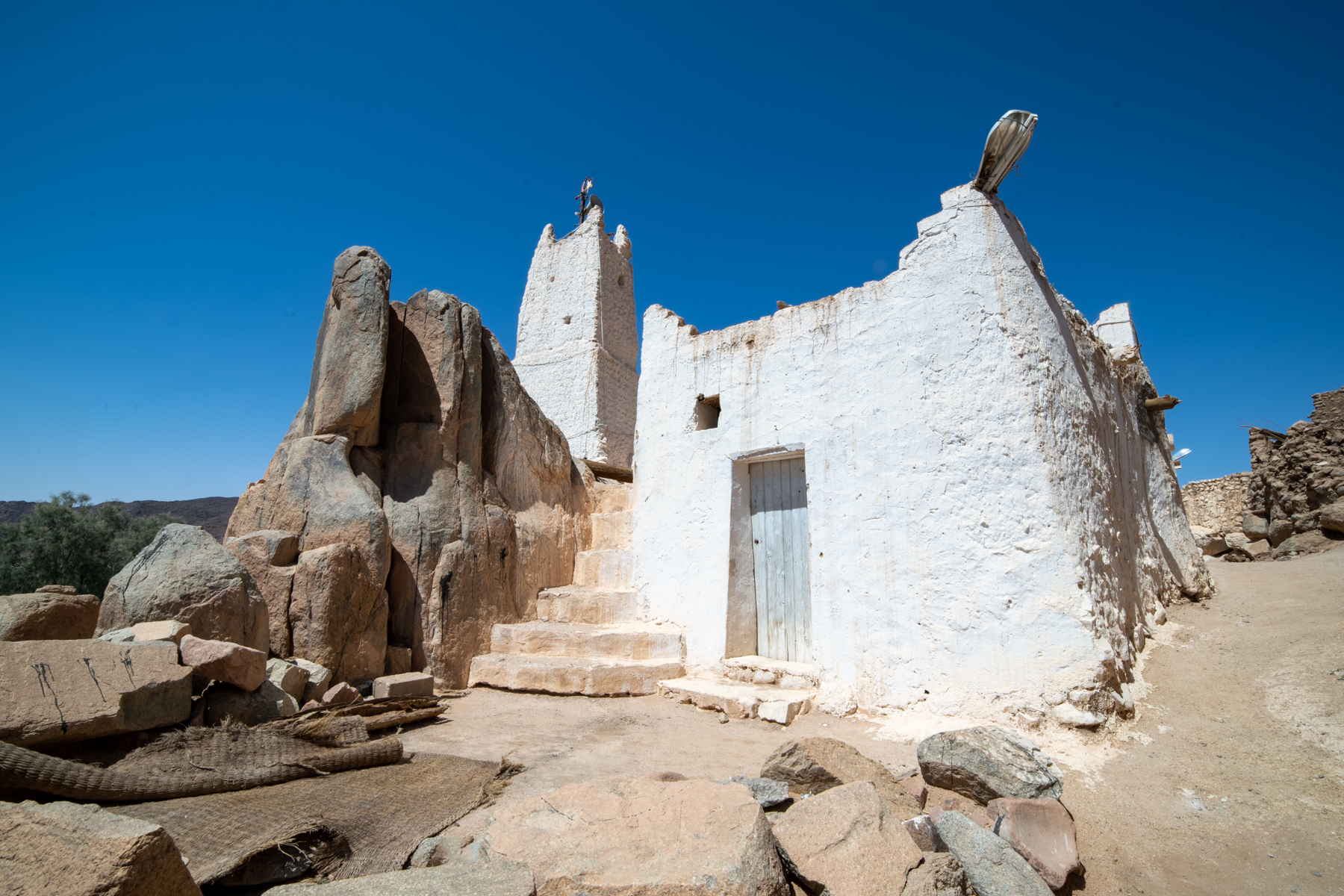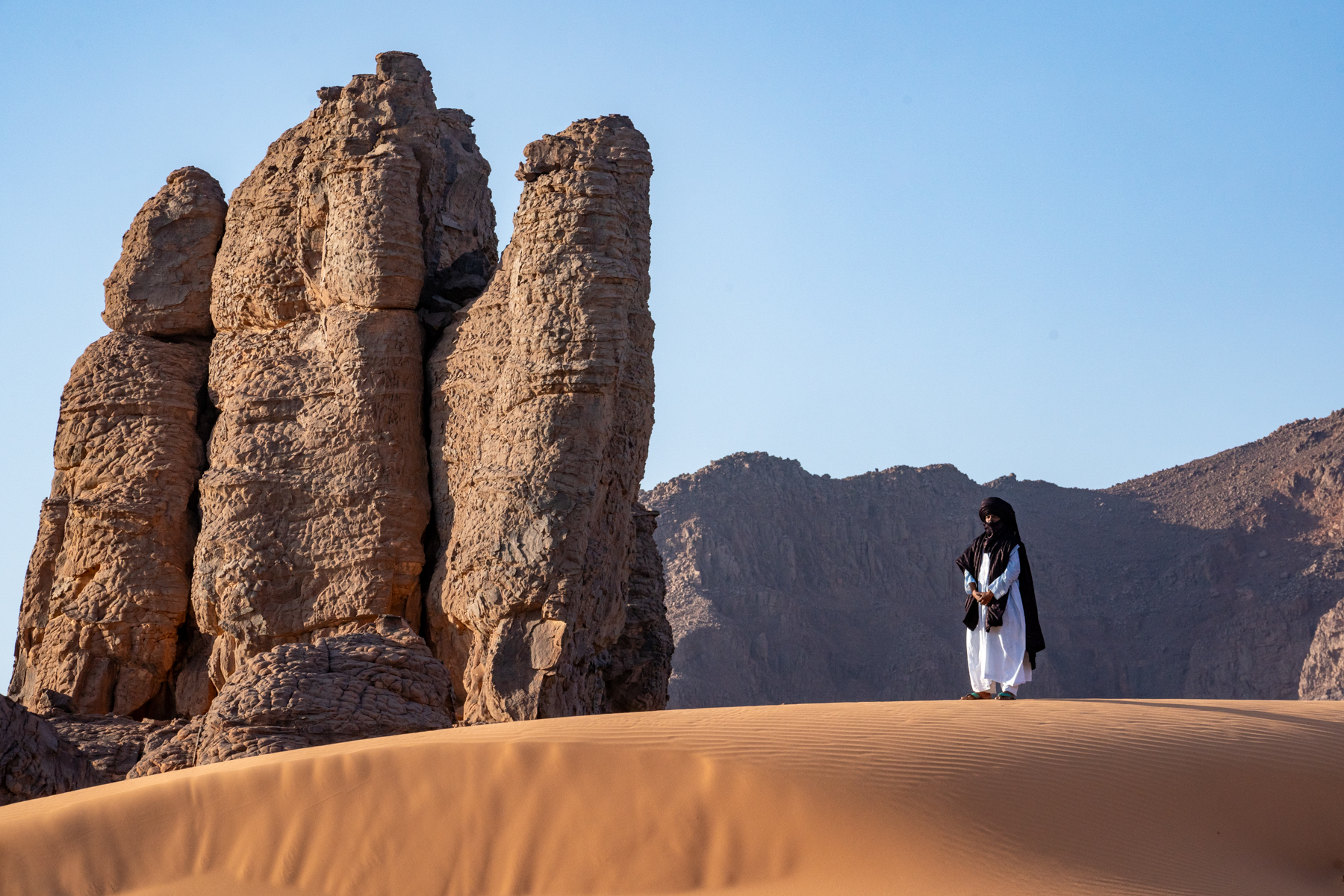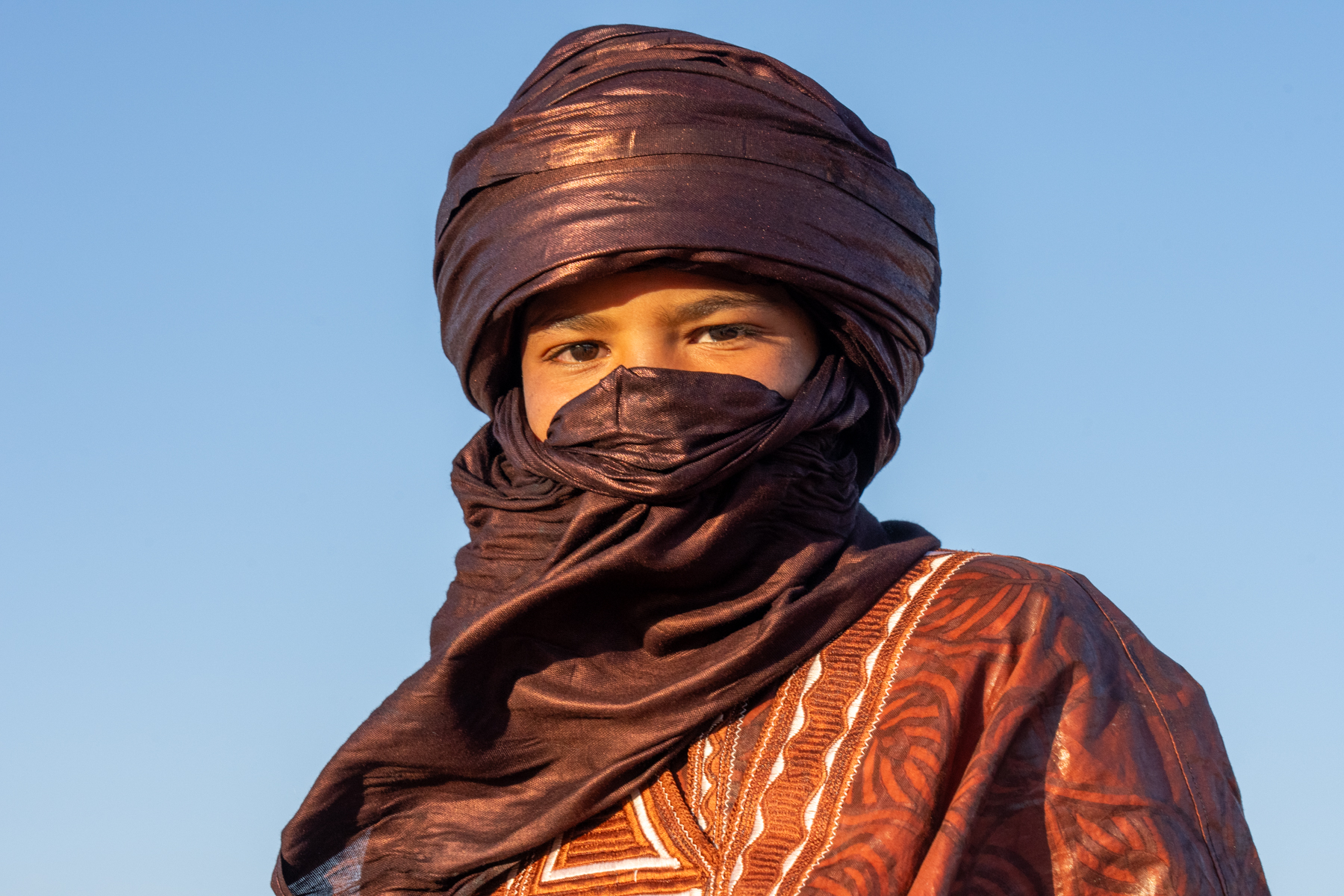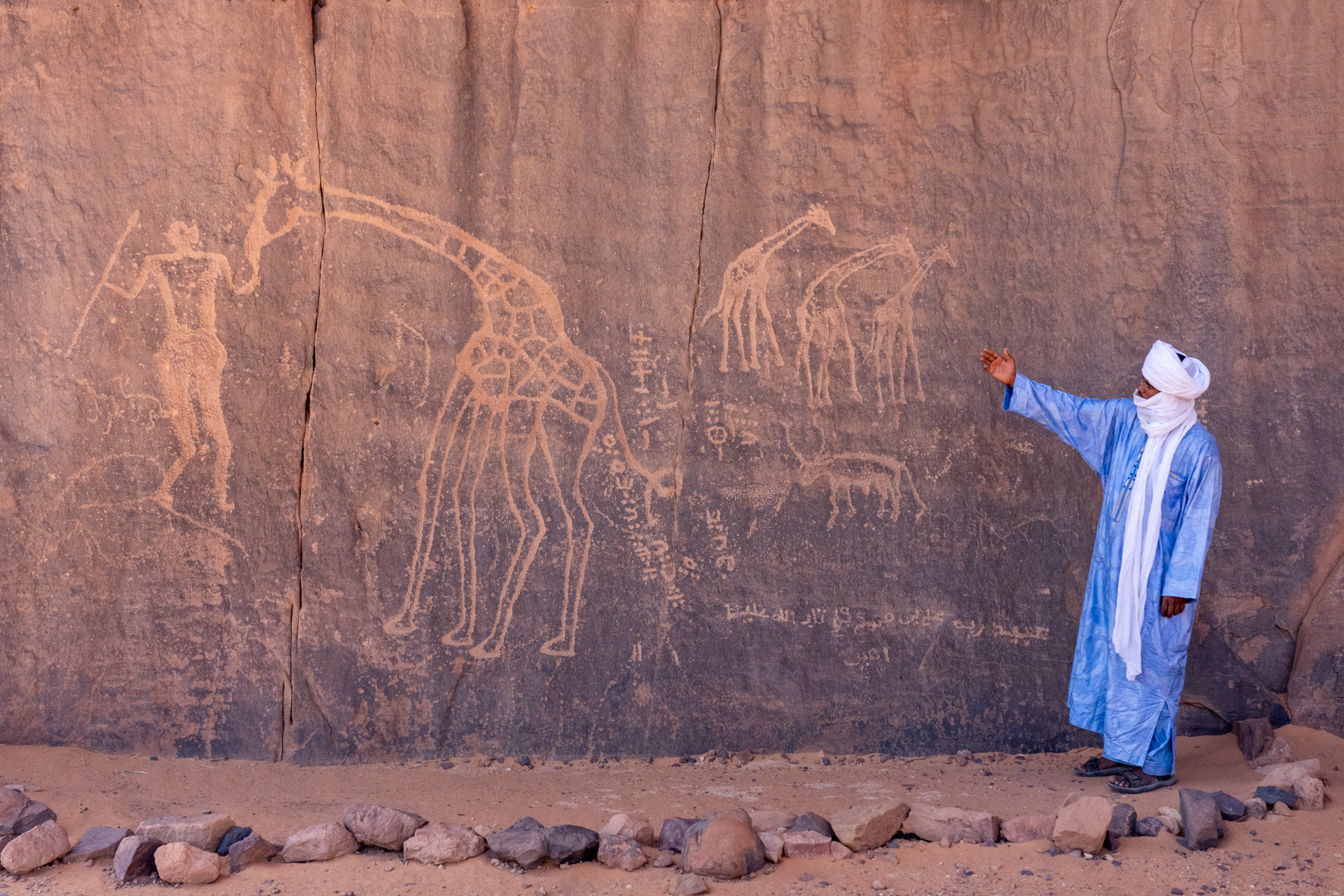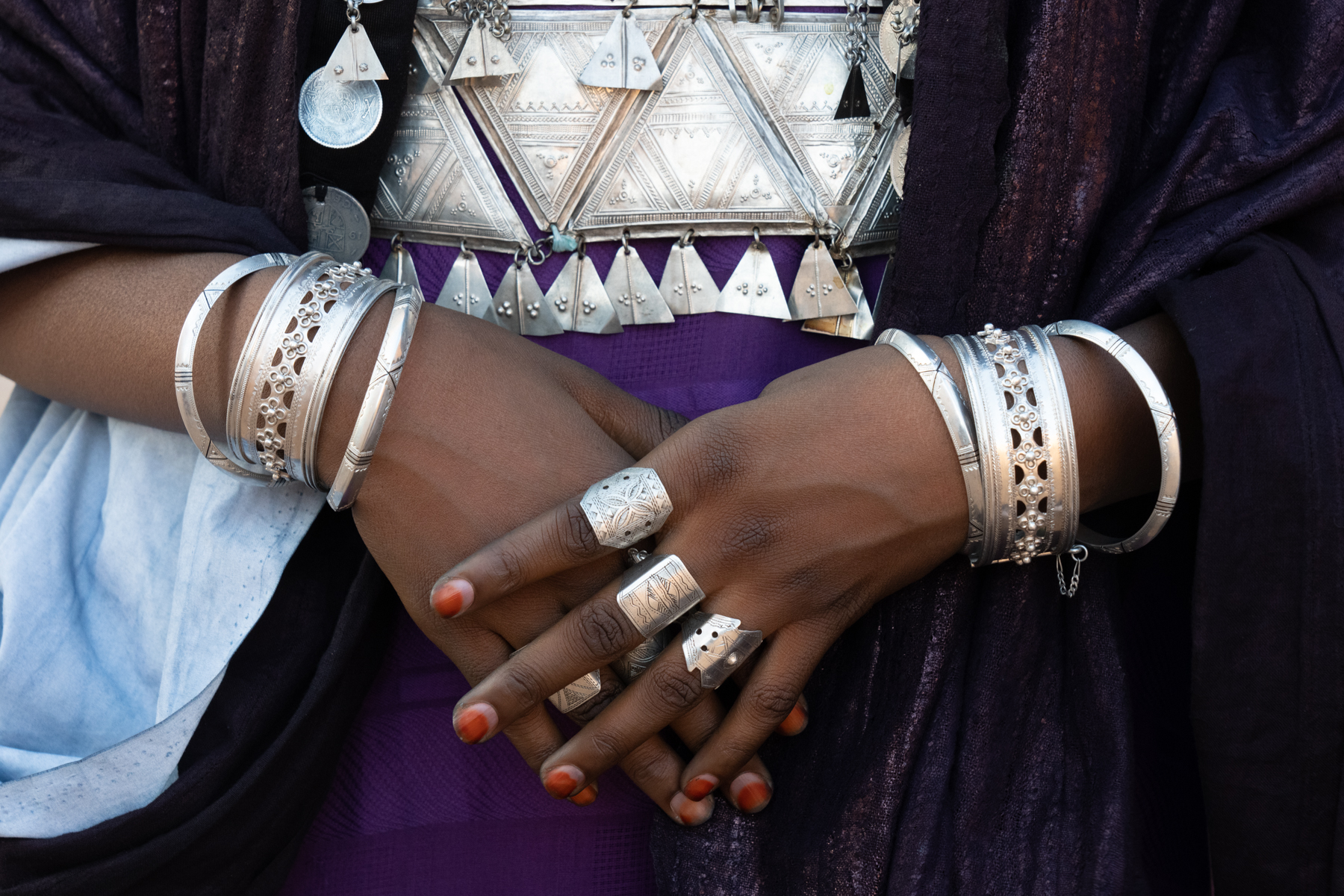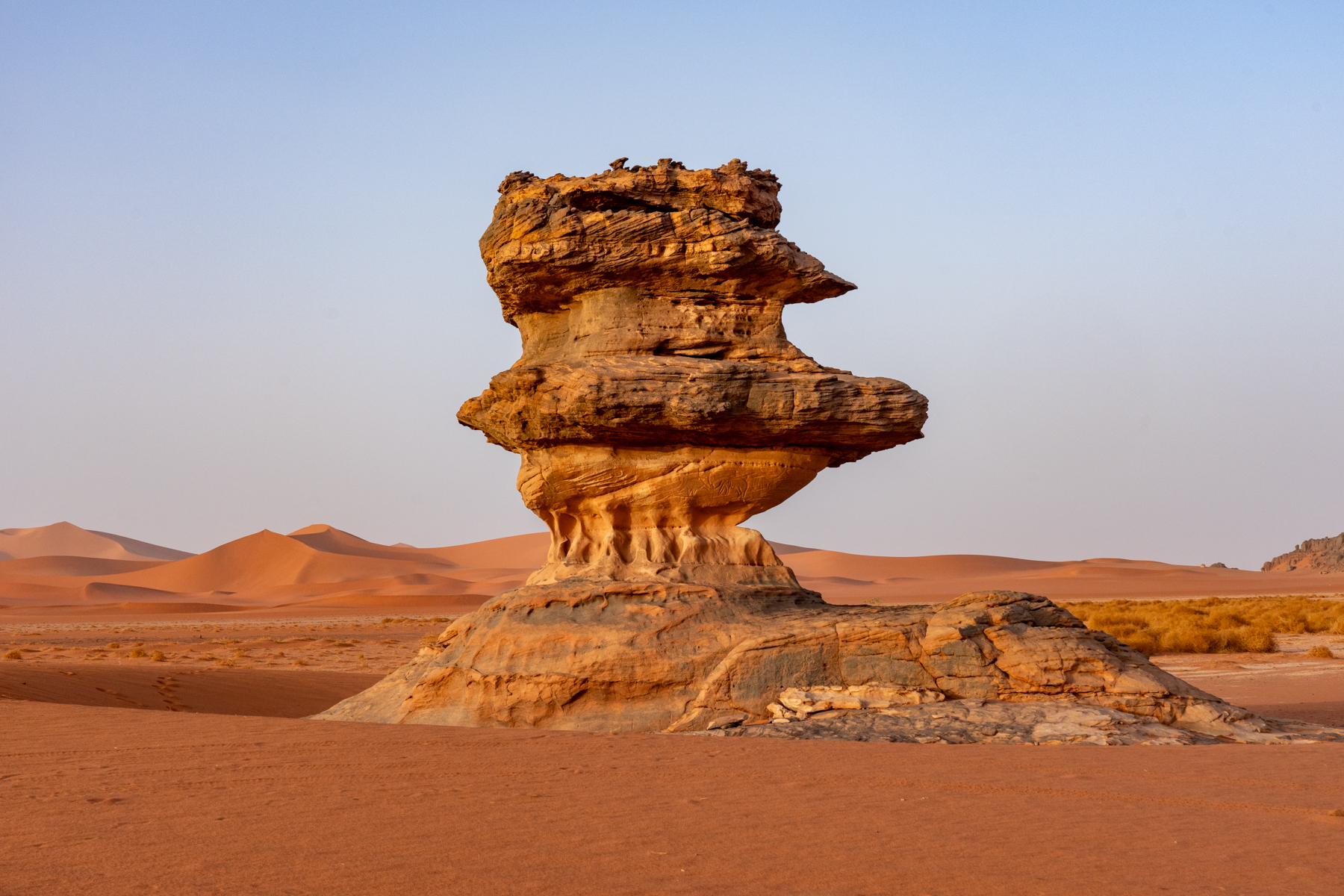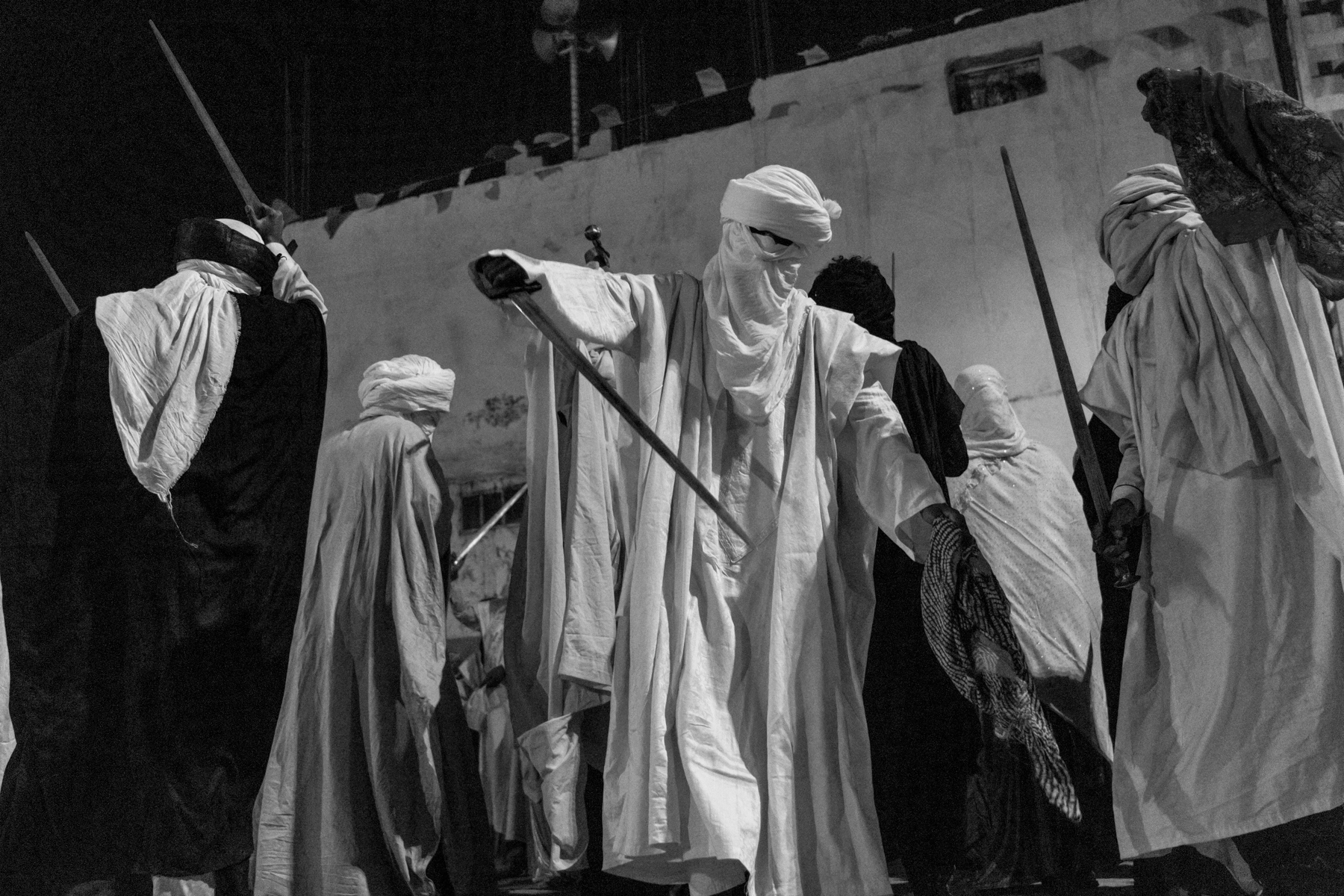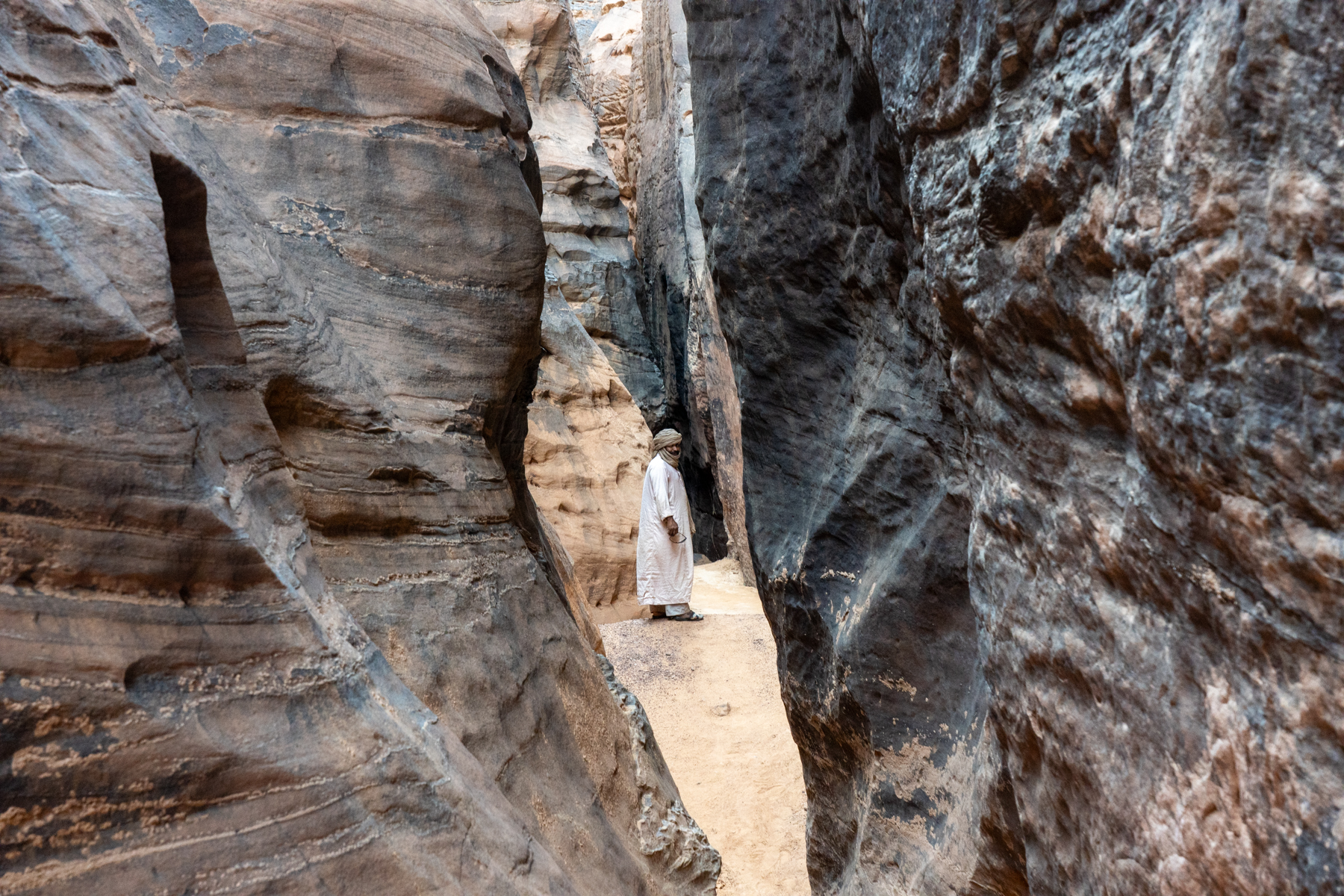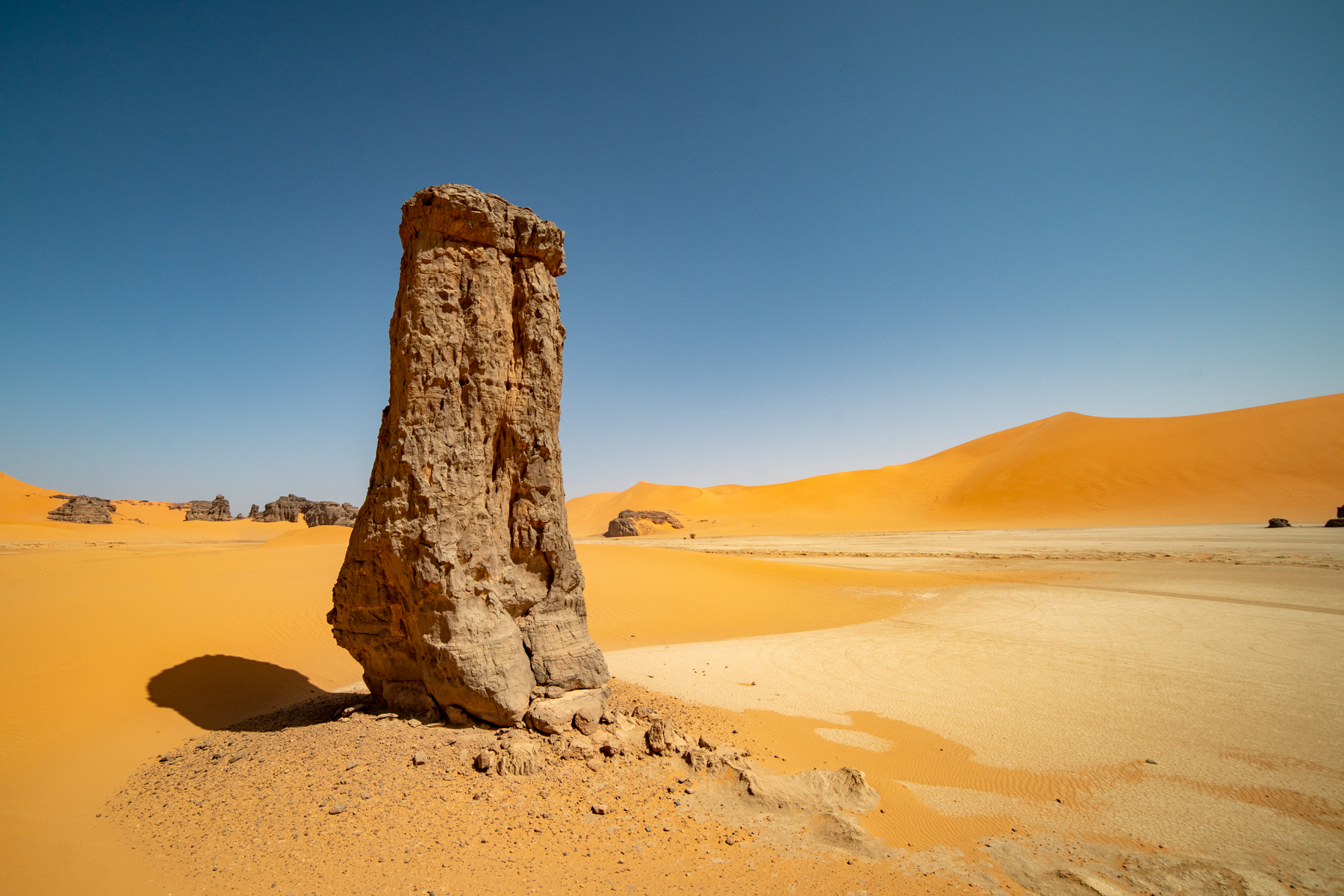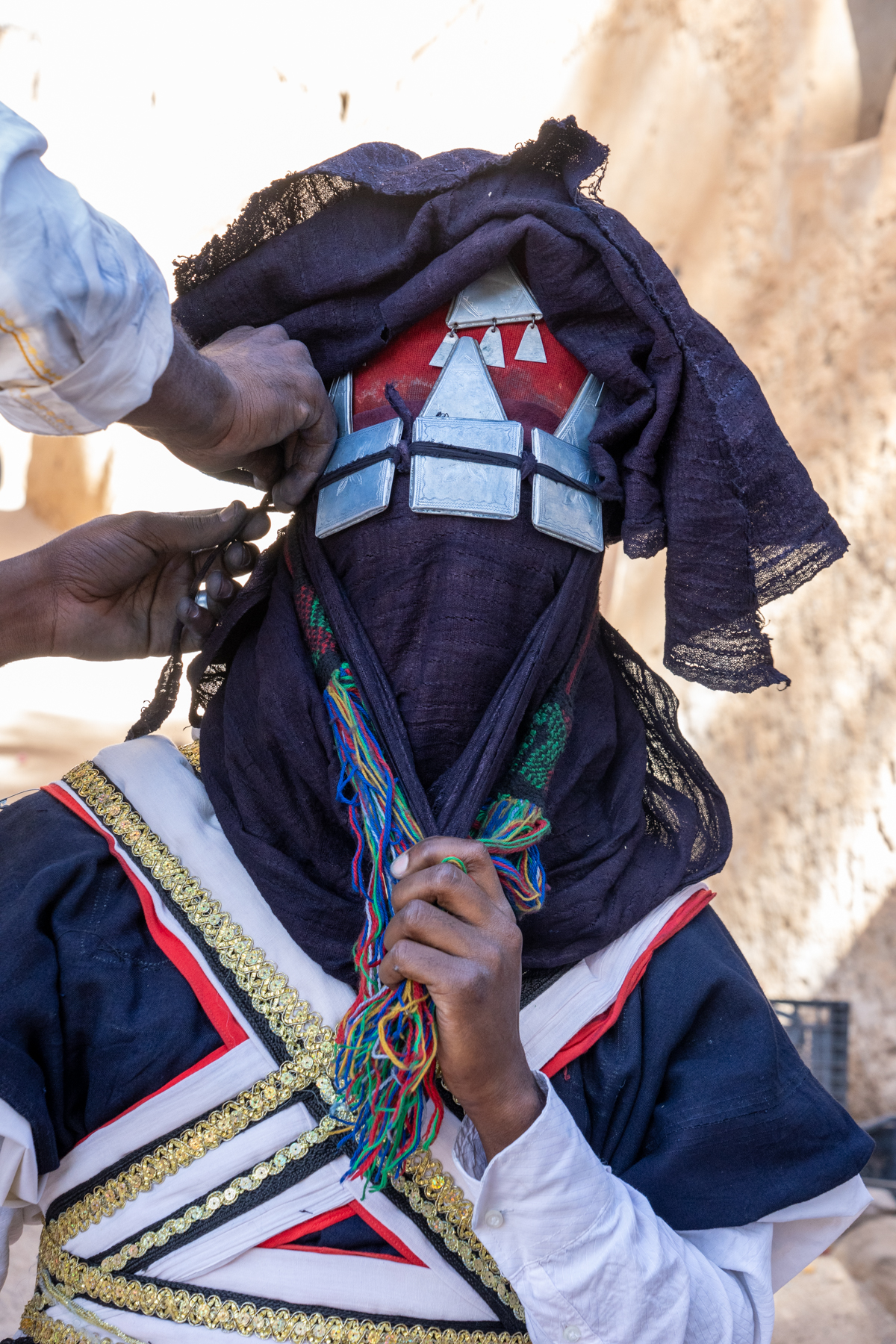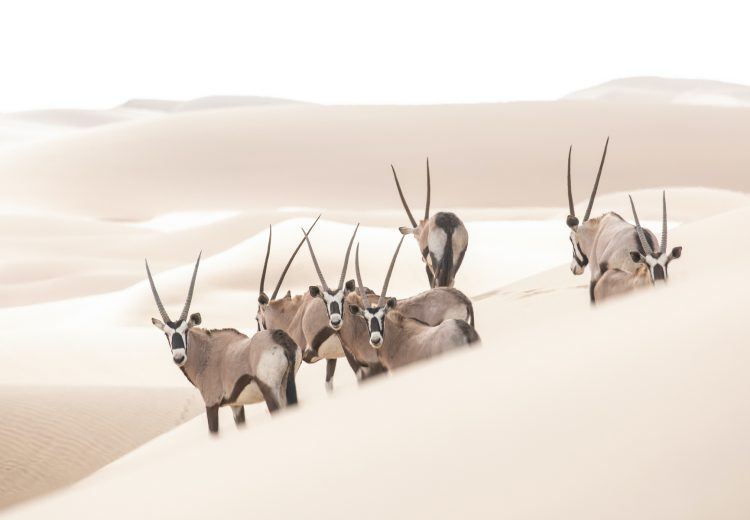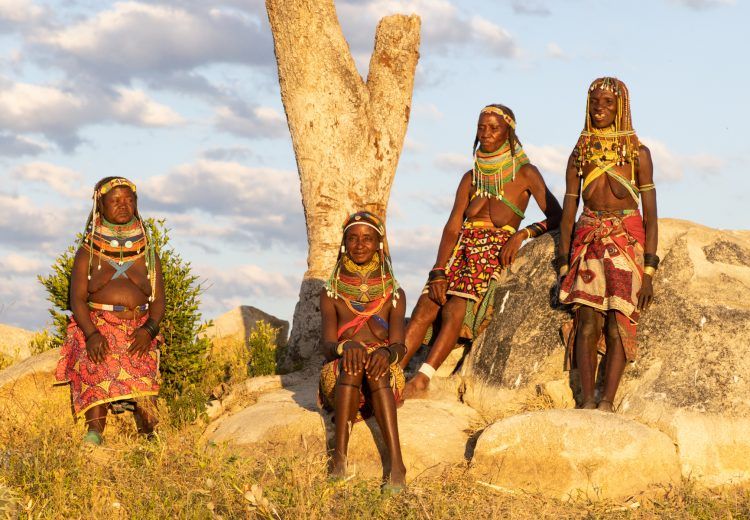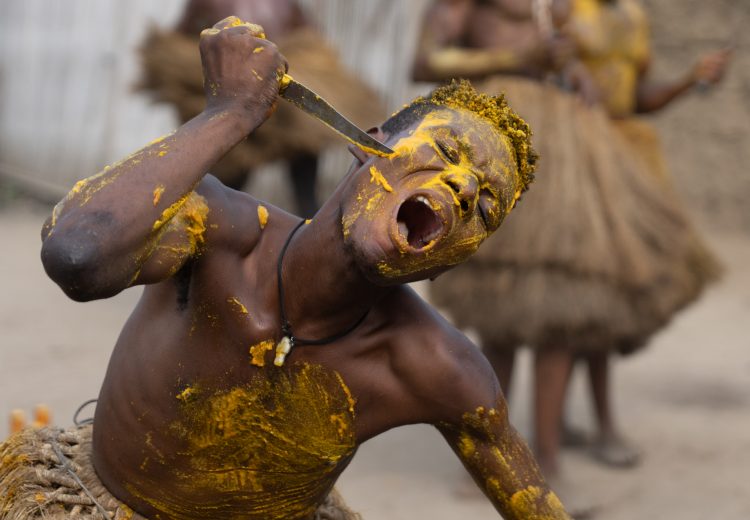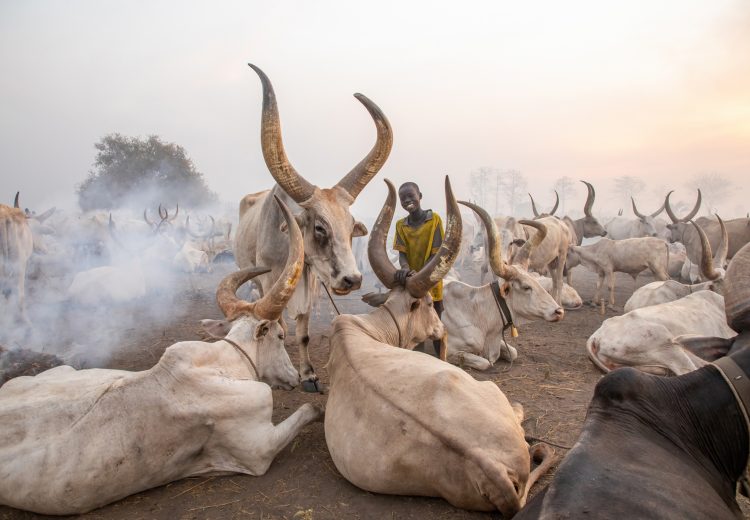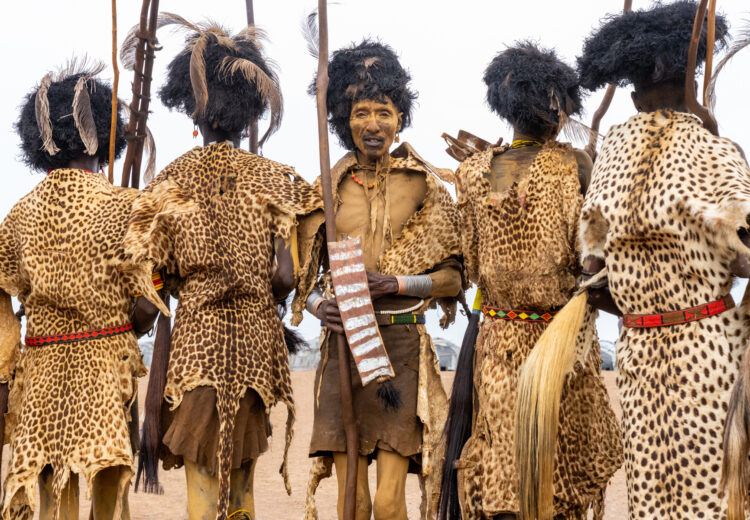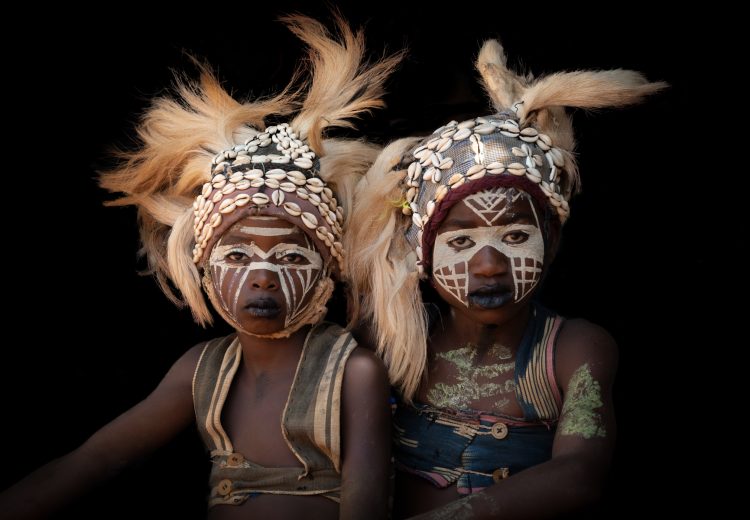Algeria
ALGERIA: Tuaregs of the Algerian Sahara






































































Engraving of an elephant pooping - it just goes to show that even ancient artists had a sense of humour (image by Inger Vandyke)

Our Tuareg guides exploring rock art sites with us in Tadrart Rouge (image by Inger Vandyke)

A Sabiba warrior holds swathes of indigo-dyed fabric as part of the ceremony in Djanet (image by Inger Vandyke)

Portrait of an elderly Tuareg woman in the desert (image by Inger Vandyke)

A beautiful woman dressed in indigo and silver for the annual Tuareg celebration of Sabiba (image by Inger Vandyke)

The newer buildings of Taghorfit are constructed over a neighbouring hillside to the Ksour of the same name (image by Inger Vandyke)

A Tuareg man waves his hand into the air setting a raven into flight in the desert (image by Inger Vandyke)

A Sabiba warrior talks to his son to prepare him for the friendly battle of the Sabiba ceremony (image by Inger Vandyke)

Tuareg men celebrating Sabiba waving their traditional Takouba swords in the air (image by Inger Vandyke)

The lively annual celebration of Sabiba in southern Algeria (image by Inger Vandyke)

Photos rarely do the rock art of southern Algeria justice. There are so many incredibly beautiful painting sites! (image by Inger Vandyke)

Portrait of a Tuareg girl heavily adorned in traditional silver jewellery (image by Inger Vandyke)

Setting up camp in the dunes of spectacular Moul-Ennaga, Tadrart Rouge (image by Inger Vandyke)

Tuareg man wearing a spectacular Tagelmoust made from fabric dyed in deep indigo (image by Inger Vandyke)

Tuareg women dressed for Sabiba (image by Inger Vandyke)

An engraving of an elephant in Tadrart is a reminder these incredible animals used to call the Sahara home (image by Inger Vandyke)

A blue man of the desert (image by Inger Vandyke)

Beautiful Tuareg girl showing her incredible silver jewellery inside the Ksour of Taghorfit, near Djanet (image by Inger Vandyke)

Portrait of a Sabiba warrior (image by Inger Vandyke)

Camel dancers circle a group of singing women at dusk as part of a traditional Tuareg wedding ceremony (image by Inger Vandyke)

Portrait of a Tuareg camel dancer (image by Inger Vandyke)

Our guide standing in the spectacular Timjadawin, the Cathedral of Tadrart Rouge (image by Inger Vandyke)

Tuareg women with their beautiful henna dyed hands for ceremonies (image by Inger Vandyke)

The incredible Timjadawin, the Cathedral of Tadrart Rouge (image by Inger Vandyke)

The ruined Ksour of Zalouaz is one of the least preserved in Djanet. It is still photogenic however (image by Inger Vandyke)

Local boy swimming in the well at the Ksour of Adjahil near Djanet (image by Inger Vandyke)

Tuareg warriors lined up to celebrate the annual festival of Sabiba (image by Inger Vandyke)

Even the desert landscapes closer to Djanet will take your breath away (image by Inger Vandyke)

A pretty young girl adorned in silver jewellery for the Tuareg celebration of Sabiba (image by Inger Vandyke)

Beautiful young Tuareg girls dressed up in traditional clothes for the celebration of Sabiba (image by Inger Vandyke)

Tuareg men use their bare feet to steer their camels (image by Inger Vandyke)

Beware of Camels sign on the road that links Algeria to Niger and Libya (image by Inger Vandyke)

A Sabiba warrior preps his young son for the ceremony (image by Inger Vandyke)

Portrait of a Kel Hoggar Tuareg man in Djanet (image by Inger Vandyke)

On a private shoot with Tuareg warriors preparing for Sabiba (image by Inger Vandyke)

Exloring ancient engraving sites near Djanet (image by Inger Vandyke)

Tea in the Sahara (image by Inger Vandyke)

Sleeping in a cradle of warm sand, covered by a blanket of a million stars. This is our camp at Moul-Ennaga in the Algerian Sahara. Dinners are sheltered from the wind by Tuareg mats and are delicious! (image by Inger Vandyke)

Dancing in the dust. Warriors celebrating Sabiba, a UNESCO world heritage listed event for its importance to Tuareg and Algerian culture A Sabiba warrior talks to his son to prepare him for the friendly battle of the Sabiba ceremony (image by Inger Vandyke)

A Tuareg man dressed in a flowing Gandara and Tagelmoust for a private shoot in the desert near Djanet (image by Inger Vandyke)

The beautiful turquoise beaded Tanba shoes worn by Tuareg men in celebrations (image by Inger Vandyke)

Inside the beautiful preserved Ksour of Taghorfit (image by Inger Vandyke)

Stopping at the hillock art site of Tabogayt en-route to Tadrart Rouge (image by Inger Vandyke)

Exploring the grave site of Ghawen, a Chadian trader from Djanet's ancient past (image by Inger Vandyke)

The stunning ancient Ksour of Taghorfit is constructed in an adobe style with mud walls supported by logs of date palms. It is one of the most beautiful regional sites of vernacular architecture we will visit on our tour (image by Inger Vandyke)

Tuareg women at Sabiba (image by Inger Vandyke)

Tuareg man wearing a multi-layered Chech, the everyday wear for men in Tuareg culture (image by Inger Vandyke)

Our guide sits in one of the many rock arches we will visit on our tour (image by Inger Vandyke)

Tuareg girls laughing between themselves at Taghorfit (image by Inger Vandyke)

Sabiba warrior in monochrome (image by Inger Vandyke)

The dusty air of Sabiba, the highlight of our tour and also one of the most prominent celebrations of Tuareg culture in Algeria (image by Inger Vandyke)

Tuareg people are famous for their silver, leather, mat weaving and textile craftmanship, much of which is sought after by collectors around the world (image by Inger Vandyke)

A traditional Tuareg leather tea making bag in the Sahara (image by Inger Vandyke)

At ease and completely at home, the Tuareg are truly the emperors of the Sahara desert (image by Inger Vandyke)

Swathed in indigo, Tuareg men are truly the Blue Men of the Sahara (image by Inger Vandyke)

Desert sunburst near Djanet (image by Inger Vandyke)

The small mud mosque inside the ancient Ksour of Zalouaz is one of Djanet's hidden architectural gems (image by Inger Vandyke)

Sabiba warrior dressed up for a private shoot near the base of Taghorfit (image by Inger Vandyke)

A Tuareg man adorns a spectacular corner of the Sahara close to the town of Djanet in southern Algeria (image by Inger Vandyke)

Young Tuareg boy waiting to watch the camel dancing in the desert (image by Inger Vandyke)

The giraffe engravings at Wan Ahar in Tadrart Rouge (image by Inger Vandyke)

A spectacular selection of Tuareg silver jewellery. Each piece has a special meaning for the wearer (image by Inger Vandyke)

Dotted around Tadrart Rouge is countless wind and water eroded rock pillars. Even this one has an engraving of an elephant under its largest layer (image by Inger Vandyke)

Night time practice (rehearsal) session for Sabiba called Timoulawine (image by Inger Vandyke)

Exploring a gigantic slot canyon in Tadrart Rouge (image by Inger Vandyke)

Stunning Taghorfit Ksour (image by Inger Vandyke)

Rock island in a sea of sand at Tadrart (image by Inger Vandyke)

Preparing the warriors for Sabiba is a detailed and intricate process (image by Inger Vandyke)
|
Tuesday 24th June –
Monday 7th July 2025 Leaders: Inger Vandyke and highly skilled local ethnographic guides |
14 Days | Group Size Limit 7 |
|
Sunday 14th June –
Saturday 27th June 2026 Leaders: Inger Vandyke and highly skilled local ethnographic guides |
14 Days | Group Size Limit 7 |
TUAREGS OF THE ALGERIAN SAHARA: OVERVIEW
There are few places in the world as beautiful as the Sahara desert in southern Algeria. This secluded corner of the world’s largest desert is a wonderland of sensual landscapes that includes dunes, wind sculpted rocks, dramatic escarpments, slot canyons, caves and stunning verdant oases. Hidden inside this stunning geography is countless art and historical sites that tell the story of life in the Sahara centuries ago.
After 14 years of effectively being cut off from the outside world and closed to tourism this incredible region of Algeria only opened its doors to tourism in 2021. Wild Images travelled there on an exploratory visit in the summer of 2023 and we are now pleased to offer a unique adventure in this incredible wilderness, exploring all of it with the Tuareg who know this land intimately and call it home.
Private photo shoots, stays with semi-nomadic Tuareg families, ceremonies and desert sojourns are all highlights of this desert odyssey that will introduce you to places seen by few people from the outside world, a world that remains untouched, wild and breathtakingly beautiful.
Wild Images has worked closely with a wonderful community of Tuareg people to create an expedition that is guided by Tuareg, on Tuareg terms. It is the first tour of its kind to gently and respectfully explore the world of Tuareg people while travelling through an unimaginably spectacular corner of Africa.
THE TUAREG
Deep in the south-eastern corner of Algeria lies the tiny and charming desert town of Djanet. It sits in a palm filled oasis enveloped by the dunes and rock pillars of the Sahara on every side. This charismatic town is almost completely inhabited by the Tuareg, the proud denizens of the Sahara who now characterise it with their culture at every turn.
In Algeria, when the Tuareg were nomadic, they spent centuries expertly wandering the vast expanses of the Sahara using only the sun, moon and stars as their guide. No single group of people know and understand the Sahara better than the Tuareg. They don’t just understand its geography, they ‘feel’ the character of the desert according to the colour of the sand, the shape of dunes or the shadows of rocks.
Their noble presence, and statuesque appearance fills you with a deep respect and awe the minute you meet them, while their deep indigo robes give them their legendary name of the “Blue Men of the Desert”.
In present day Algeria there are extremely few truly nomadic Tuareg people. Through a combination of climate and political changes, almost all of them reside in towns or in semi-nomadic camps close to water.
While many Tuareg may have left their traditional desert homes, their culture is still very much alive and well in southern Algeria. The Tuareg have always had a special affinity with elegance. Tuareg men and women adorn themselves in rich brocades, silver jewellery and leather talismans as a part of their beautiful culture. During their every day, many men still wear a long, flowing Gandara robe and they cover their faces in cloth called ‘chech’. Tuareg women conservatively wear hijab. During the time they celebrate weddings and festivals, this traditional dress switches to the iconic indigo ‘Tagelmoust’ or headdress worn by Tuareg men and indigo robes adorned with silver jewellery worn by Tuareg women.
To spend time any time around Tuareg people is special, whether you meet them in the street, sit drinking tea with them or share a meal of Tagella with a Tuareg family in the desert under a night sky. Their warmth and gracious hospitality is legendary in the Sahara.
TUAREG CEREMONIES
Dancing Camels
Once a year the incredible Tuareg gather their clans for ceremonies. It is a time of tradition, honour and celebration that features weddings, dances and the famous Sabiba, the annual festival of Tuareg warriors.
Tuareg weddings last, on average, three days. Given the huge expense of running these events, couples tend to share their special day with other couples from the same Tuareg clan. It is a time of much love and happiness in young Tuareg people.
While weddings are a strictly private affair, one of the more public displays you can visit as a guest is that of the Dancing Camels. Taking place late in the afternoon, highly decorated Tuareg men adorn their camels with brightly coloured leather saddles and brass drinking bowls before they march them out to the desert. They walk out to meet Tuareg women, who have gathered with their Tinde drums to sing, clap their hands and welcome the Tuareg cameleers to the ceremony.
Camel races and rides culminate in Tuareg men circling the group of women singing, in this beautiful ceremony, which ends with the final blush of day.
Wild Images has arranged a private dancing camel ceremony alongside a private photography shoot with the traditionally dressed cameleers and other Tuareg people in the desert close to Djanet. Taking place at sunset and for our group only, this beautiful ceremony is one of the most photogenic we will see on our tour.
Timoulawine
Taking place in several locations dotted around the oasis of Djanet, Timoulawine is the official rehearsal for Sabiba.
Taking place at night, when the heat of the desert is dissipated by the cool evening air, Timoulawine rehearsals usually happen for a few nights prior to the main event of Sabiba.
We will join crowds of friendly locals assembling to practice dancing, singing and tradition. While photography at these can be a little challenging due to the low light, the sheer act of being surrounded by Tuareg men waving their Takouba swords in the air, to the rhythmic music performed by Tuareg women, is mesmerising.
Sabiba
The most spectacular event on the annual Tuareg calendar in southern Algeria is the celebration of Sabiba.
Inscribed by UNESCO on the Representative List of the Intangible Cultural Heritage of Humanity in 2014, The ritual and ceremonies of Sebeïba are practised by two communities of Tuareg people living in Djanet during ten days in the first month of the Islamic lunar calendar.
Tuareg male dancers, dressed as warriors, and female singers walk to a place called a ‘Loghya’ for the performance of the ritual. Once there, the male dancers parade and present their weapons, while they walk a ritual circle rattling their swords continuously as the women sing traditional songs to the rhythm of the drums. At the end of the day, the participants disperse. Knowledge related to the ritual and ceremonies is transmitted directly from older to younger members. Local craftspeople produce and repair the uniforms, weapons, jewellery and musical instruments required for the ritual and ceremonies.
The Sabiba ritual and ceremony is an important marker of cultural identity for Tuareg people living in the Algerian Sahara. It reinforces social cohesion, symbolically warding off potential violence between rival communities by simulating and transposing it to the realm of artistic competition.
We have arranged to visit a group of Sabiba ceremony performers as they prepare for this incredible event. This privileged glimpse is a ‘behind the scenes’ of Sabiba where we will be able to photograph the dancers away from the bustle of the crowds that travel to Djanet en-masse for this festival held once a year.
EXPLORING THE KSOURS – ALGERIA’S RICH VERNACULAR ARCHITECTURE
Crowning the neighbouring hillsides of Djanet are three ancient Ksours, or hill fortresses, who once formed the ancient bases of civilisation in this part of Algeria. Exploring each of these historic centres will give you a first-hand experience of life in a labyrinth of beautiful Algerian vernacular architecture.
Varying in terms of preservation we will visit all three of Djanet’s Ksours on our tour.
Zalouaz
Perhaps the most run down of Djanet’s Ksours, Zalouaz sits nestled in gigantic granite boulders where its crumbling walls and labyrinth of dirt paths once formed a centre of trade with merchants travelling from neighbouring Niger, Sudan, Libya and Chad.
While most of the Ksour is in rubble, wandering through the dirt streets of this former community will lead you to a tiny mud mosque that has been sculpted into the hillside. It is the best preserved building of this complex and an unexpected highlight of any visit to Zalouaz.
Adjahil
Adjahil sits on the opposite hillside of the two other Djanet Ksours. It is characterised by its source of water and there are still residents visiting it daily with one house still occupied by a family.
It is blessed by two fresh water springs, one called Talam Ayis which feeds a well where tragically a horse and even people have drowned. Yet in defiance of its depth, some of the local children visit it to swim and another called Telarlarlart which feeds into a pool used for irrigation and watering livestock
The foundations of Adjahil were supposedly built by a trader who moved to Djanet from Tibesti in northern Chad.
Walking around the complex today allows you to explore this ancient past and visit the prolific cemetery of its residents on a nearby hill.
Taghorfit
Of all the Ksours in Djanet, the spectacular buildings of Taghorfit are the best preserved. A subject of much architectural interest, a local preservation society ‘keeps’ Taghorfit and regularly renovates the Ksour walls, creating an atmosphere of a lost ‘hilltop world’.
The buildings of Taghorfit feature adobe walls supporting large beams, ladders and even staircases made from local date palm wood.
It is at once earthy and homely, yet extremely sophisticated and stylish.
We will visit Taghorfit twice on our tour. Once to simply enjoy wandering its narrow alleyways and another to photograph Sabiba dancers in this beautiful charismatic Ksour.
THE ALGERIAN SAHARA
The Sahara desert of Algeria is home to some of the most impressive landscapes on earth. The entire region is a photographers dream. It has no light pollution and the whole area looks like one great big sculpture park and art gallery combined. For us it is called the Sahara. For the Tuareg it is the Ténéré, a place where emptiness reigns and survival is harsh.
Our tour will explore two key regions of south eastern Algeria – the astonishing Tadrart Rouge which is uninhabited but incredibly majestic and Erg Admer, which has a permanent water source in a spring fed oasis that is home to numerous semi-nomadic Tuareg families.
We will also enjoy a short excursion into the desert night searching for nocturnal wildlife including Jerboas and possibly Fennec Fox plus a variety of desert insects like urchin and scarab beetles, scorpions and wind scorpions.
In both regions we will explore numerous rock art sites that lie as evidence of life that existed in the Sahara centuries ago.
There is barely no greater site for ancient rock art in the world than the Tassili Plateau in southern Algeria. This spectacular tract of desert is home to countless art sites dating back to the Neolithic period.
The desert art of Southern Algeria takes three forms, all of which we will explore on our tour. Our local Tuareg guide is extremely well versed in the history and age of these sites we will visit, including the stories behind them.
Petroglyphs
During our inaugural photo tour to this region we explored over three dozen sites, many of which featured paintings of hunters, traditional life, bulls, antelopes and spiritual figures.
Every single one of them was unique, intricately painted and represented a glimpse into the world of the ancient Sahara.
We also explored the red ochre stones and ‘paint pot’ pits where paints were mixed by these artists while they worked.
Engravings
Scattered all over southern Algeria are sites with engravings that hark back to a time when the Sahara was a fertile land mass that featured savannahs, rivers, and forests. The evidence of these times is mostly depicted now in engravings that include giraffes, elephants, bulls and antelopes. Some of the sites we will visit on our tour are famous and well know like ‘The Crying Bulls’, whose legend tells of a shepherd that took his cows to what he thought was a reliable source of water. When he arrived the water had dried up and as his cows died from dehydration, they began to cry. He engraved their images on a vertical place of rock in their memory.
Fossils
A surprising aspect of our initial exploration of Tadrart was the number of fossil sites we visited, some of which featured whole ecosystems of plant life and the footprints of both wildlife and humans.
Other Highlights
During our drives in the desert we will also find ancient graves where we will explain the history of the person who has died and has been laid to rest.
We will also visit a stunning spring fed oasis where we might even get a chance for a swim!
TADRART ROUGE – THE JEWEL OF THE ALGERIAN SAHARA
Imagine a desert world plunged deep in the middle of nowhere. A remote wonderland of rock art, slot canyons, caves, overhangs, rock pinnacles and dunes. This is Tadrart Rouge, one of the most scenically beautiful corners of the entire Saharan realm.
There is simply nothing in the world like spending time in a desert that is so remote and unpeopled like Tadrart Rouge. The overwhelming silence of this desert almost heightens all of your senses. Early mornings and late afternoons are spent exploring the numerous art sites, stunning desert landscapes and wind eroded rock pillars. During the middle of the day, long siestas are enjoyed in the shade of rocky overhangs or carefully selected sites to escape the heat. At night, you sleep in a cradle of sand under a blanket of a million stars.
Exploring Tadrart Rouge, with its impressive entry valley of Injaran and the otherworldly expanses of the mysterious ‘le cirque’, is a bit like wandering through a gigantic sculpture park pockmarked with slot canyons, caves, rock pillars and mountains. Being there with Tuareg people, drinking their customary three cups of tea, sharing dinners over open fires, and listening to them laugh between themselves creates this magical atmosphere that you wish could linger.
Even with the relative hardships of travel there, it is hard to leave Tadrart.
Our tour will spend five days in this region exploring the various sites on foot and by 4WD with our Tuareg team.
ERG ADMER – A HAVEN OF SEMI-ARID LIFE AT THE EDGE OF THE TÉNÉRÉ
The second location we will explore on our tour is Erg Admer. Lying closer to Djanet but to the west, Erg Admer’s topography is slightly different, yet no less spectacular than Tadrart Rouge.
Unlike Tadrart, Erg Amer has a permanent oasis fed by a water spring. As such the area is home to several semi-nomadic Tuareg families.
It is here we can enjoy a swim in one of the emerald pools of the oasis, providing a much needed cool off in the desert.
It is also a region that is home to famous rock engraving sites like ‘The Crying Bulls’ and ‘Tin Taghirt’ with its beautiful engraved bull artwork.
During our time in Erg Admer we will enjoy a privileged visit to a family of semi-nomadic Tuareg people where we will learn about their way of life.
We will also visit the gigantic funerary sites of Tamboo and Tikoubaouin, where mysterious circular grave stone formations adorn a nearby hill.
Finally as a highlight to our time in Erg Admer we will head to the spectacular dune lookout of Tadjedit which offers one of the finest sunset photography locations of our entire tour.
WHY TRAVEL TO THE ALGERIAN SAHARA WITH WILD IMAGES
In the summer of 2023, Wild Images pioneered photography tourism with the Tuareg of southern Algeria. During that trip we worked closely with a local community to create an experience that is run almost entirely on Tuareg terms, respecting their cultural boundaries and traditions, while gently exploring their world.
Our tour is in stark contrast to generic desert tours where your only interaction with Tuareg people comes from your hosts who take you to the desert.
During the tour we will not only explore Tuareg culture and ceremonies, we have organised private photo shoots with local people to stay away from the crowds.
Rather than simply eating dinner in a local restaurant, where possible we will go out into the desert and join local people at meals cooked over an open fire, drink tea and enjoy Mechaoui, or listening to iconic local music from this region including Tinariwen, Imarhan and Nabil Baly Othmany.
Important regarding the Tour Dates
Because the festival dates of Sabiba are not precisely known until around one year ahead, the exact tour dates are only provisional until that time. If you book for this special tour, please be sure not to arrange other commitments for 5 days either side!
Accommodation, Meals & Road Transport
The hotel we use in Djanet is a basic standard. In Tadrart Rouge and Erg Admer, we will stay in very simple camps. There will be 2-man tents (but each person can have their own tent: couples may prefer to use one tent for luggage). Some guests may prefer to simply sleep on mattresses on the sand and watch the starry night sky until they fall asleep.
All meals will be provided and cooked by our support staff. Our meals will be a combination of local Tuareg dishes, fresh fruit and western cuisine. Vegetarians and Vegans can be catered for.
Due to the extreme lack of water in Tadrart there will be no washing facilities. It is wise to bring wet wipes for your time in the desert. Toilet visits are taken behind a rock or involve a lone walk into the wilds!
The transport for the Algeria expedition will be by 4×4 vehicles. Roads in Algeria are better than you might expect with tarred roads and few potholes. Once we leave those roads to visit the desert we will be on dirt or sandy tracks.
Walking
The walking effort during our Algerian photography expedition is relatively easy almost throughout. The only more difficult walks will be around the hillside Ksours which have uneven rocky pathways and to the top of some of the dunes in Tadrart which are quite high. All of the walks on uneven ground are optional.
Climate
Typically it will be extremely hot, dry and sunny in the parts of Algeria being visited. During the daytime in Tadrart temperatures can reach the mid 40 degrees Celsius. At night the temperature drops to a more pleasant 25 degrees Celsius. Early mornings can be cool enough to use a light sleeping bag. During the middle of the day we will have customary siestas to avoid the worst of the heat and harsh light.
Photographic Equipment
This trip is mainly a combination of people and landscape photography. We will also be doing a night walk in the desert searching for creatures including small mammals, insects like Urchin and Scarab beetles, Wind Scorpions and general scorpions that fluoresce.
For photography with the people of Algeria, we recommend a travel lens such as a 24-105mm or a 70-200mm on a DSLR or mirrorless camera, or a point-and-shoot camera, or even iPhones and iPads.
This part of Algeria has very little light pollution. As such it is a magnificent region for celestial photography. For landscape and night photography we suggest you bring a wide-angle lens plus a tripod.
Please note that drone photography is strictly prohibited in Algeria.
If you have questions about what equipment you ought to bring, please contact our office.
Photographic Highlights
- A thrilling desert adventure with the highlight of photographing Sabiba, the annual festival of Tuareg warriors, a UNESCO listed event for its cultural significance to mankind
- Five full days in Tadrart Rouge exploring the landscapes, historical and art sites in one of the most beautiful desert landscapes on earth
- Private photo shoot with Tuareg people and camel dancers in the desert
- Private photo shoot with Tuareg men and women dressed for the annual celebration of Sabiba
- Three days in Erg Admer meeting a semi-nomadic Tuareg family, swimming in an emerald oasis and photographing one of the most beautiful sunset sites in the region
- Night walk in Tadrart searching for nocturnal desert wildlife
- Visit local Tuareg silversmiths and leather artists
- Explore a local farming community for Tuareg people
- Enjoy an evening of Mechaoui – the iconic music of the Tuareg like Tinariwen, Imarhan, and Nabil Baly Othmani, with dinner in the desert
- Join a Timoulawine rehearsal of Sabiba
- Explore Djanet’s three ancient Ksours and photograph their stunning vernacular architecture
- The first tour of its kind designed by Tuareg with Tuareg people
OUTLINE ITINERARY
- Day 1: Arrival at Djanet and transfer to our hotel. Late afternoon visit to the Ksour of Taghorfit
- Days 2-6: Desert exploration of Tadrart Rouge
- Day 7: Visit the Ksours of Zalouaz and Adjahil. We will also visit a small museum of Tuareg culture in the morning. Visit Crying Bull rock art sites in the afternoon
- Days 8-10: Desert exploration of Erg Admer
- Day 11: Visit the Tin Taghirt engraving site in the morning before we return to Djanet. Dinner at our hotel before the evening event of Timoulawine
- Day 12: We will visit a local oasis where Tuareg people farm produce in small plots. We will then visit the local souk to see Tuareg blacksmiths creating some of their famous silverware. Afternoon private photo shoot with Tuareg people and private camel dance. Dinner in the desert with Mechaoui musical event
- Day 13: Morning celebration of Sabiba. Afternoon meeting Sabiba men and women for private photographs in Taghorfit. Afternoon celebration of Sabiba.
- Day 14: Departure to Algiers at Djanet Airport
To see a larger map, click on the square-like ‘enlarge’ icon in the upper right of the map box.
To see (or hide) the ‘map legend’, click on the icon with an arrow in the upper left of the map box.
To change to a satellite view, which is great for seeing the physical terrain (and for seeing really fine details by repetitive use of the + button), click on the square ‘map view’ icon in the lower left corner of the ‘map legend’.
PRICE INFORMATION
Wild Images Inclusions: Our tour prices include surface transportation, accommodations, meals and entrance fees.
Our tour prices also include all tips for local guides, drivers, camp staff, accommodation/restaurant staff. Also included are payments to local people who are willing to be photographed. This tour includes two major private photography shoots, a private camel dancing ceremony including portraits in the desert and also a private behind the scenes photo shoot with Sabiba dancers preparing for the ceremony at Taghorfit.
The cost also includes a return flight between Algiers and Djanet.
Deposit: 20% of the total tour price. Our office will let you know what deposit amount is due, in order to confirm your booking, following receipt of your online booking form.
TO BOOK THIS TOUR: Click here (you will need the tour dates)
2025: confirmed £4330, $5700, €5190, AUD8490. Algiers/Algiers.
2026: provisional £4410, $5810, €5290, AUD8660. Algiers/Algiers.
Single Supplement: 2025: £140, $180, €170, AUD270.
Single Supplement: 2026: £150, $190, €180, AUD290.
The single supplement includes a single occupancy tent while camping.
This tour is priced in Euros. Amounts shown in other currencies are indicative.
Air Travel To & From The Tour: Our in-house IATA ticket agency will be pleased to arrange your air travel on request, or you may arrange this yourself if you prefer.
Day 1
After flying from Algiers and arriving in Djanet where we will be greeted by our local Tuareg team, we will transfer to our hotel for a break before we visit the stunning Ksour of Taghorfit until sunset.
Days 2-6
The next morning we will travel out by 4×4 vehicles to the astonishing Tadrart Rouge, one of the most beautiful landscapes in the world. Over the next few days we will wild camp in the desert with Tuareg guides, explore rock art, slot canyons, caves and dunes for landscape photography. During our time in Tadrart we will also enjoy a night-spotting excursion where we will search for nocturnal desert wildlife.
Day 7
Today we will visit the beautiful ksours of Zalouaz and Adjehil, exploring each with local guides who can explain their history while we enjoy ‘street’ photography of their labyrinthine alleyways. Before lunch we will also visit a tiny local museum where Tuareg women will have a number of small, handcrafted artesan goods for sale. In the afternoon we will take an excursion into the desert closer to Djanet to visit the famous site of the Crying Bulls rock engravings.
Days 8-10
Our next three days will be spent in the beautiful semi-arid region of Erg Admer with its verdant oasis, spectacular dunescapes, ‘rock jungles’ and engraving sites. It is here we will spend time with a semi-nomadic Tuareg family and also enjoy swimming in a beautiful emerald oasis nearby.
Day 11
On our final morning in Erg Admer we will visit another beautiful bull engraving site, Tin Taghirt, before returning to Djanet for a rest. In the afternoon, after a rest, we will enjoy dinner at our hotel before visiting our first Timoulawine rehearsal for Sabiba.
Day 12
In the morning we will visit a local oasis farm where Tuareg people grow produce and raise livestock before heading to the local souk where we will meet Tuareg blacksmiths producing beautiful silver goods for sale. In the afternoon we will enjoy a private photo shoot in the desert with traditionally dressed Tuareg people before a private camel dancing ceremony for our group.
Day 13
Sabiba day. We will spend our first morning photographing the annual celebration of Sabiba. After a short break we will return to the ceremony a little earlier than it begins for a private photo shoot with Sabiba men and women at Taghorfit. Finally we will join them at the afternoon ceremony until sunset
Day 14
On our final day our tour will end with our flight to Algiers.
Please note: Our tour will take place during a time of many celebrations for Tuareg people. The order of our published itinerary may change if we hear of a special celebration not to be missed!
Algeria: The Tuaregs of Algerian Sahara Tour Report 2023
Algeria. It was the first African country I ever visited and the one that was responsible for birthing my love affair of the entire continent. It was 1990. I was 19 years old and I decided to visit Algeria for a fairly inane reason. After a few months of living in one of the coldest […]
View Report

